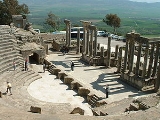
Dougga
Encyclopedia
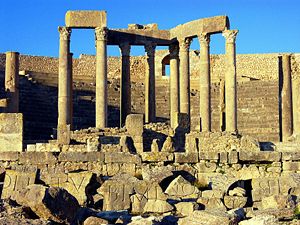
Ancient Rome
Ancient Rome was a thriving civilization that grew on the Italian Peninsula as early as the 8th century BC. Located along the Mediterranean Sea and centered on the city of Rome, it expanded to one of the largest empires in the ancient world....
city in northern Tunisia
Tunisia
Tunisia , officially the Tunisian RepublicThe long name of Tunisia in other languages used in the country is: , is the northernmost country in Africa. It is a Maghreb country and is bordered by Algeria to the west, Libya to the southeast, and the Mediterranean Sea to the north and east. Its area...
, included in a 65 hectare archaeological site.
UNESCO
UNESCO
The United Nations Educational, Scientific and Cultural Organization is a specialized agency of the United Nations...
qualified Dougga as a World Heritage Site
World Heritage Site
A UNESCO World Heritage Site is a place that is listed by the UNESCO as of special cultural or physical significance...
in 1997, believing that it represents “the best-preserved Roman small town in North Africa”. The site, which lies in the middle of the countryside, has been protected from the encroachment of modern urbanisation, in contrast, for example, to Carthage
Carthage
Carthage , implying it was a 'new Tyre') is a major urban centre that has existed for nearly 3,000 years on the Gulf of Tunis, developing from a Phoenician colony of the 1st millennium BC...
, which has been pillaged and rebuilt on numerous occasions.
Thugga’s size, its well-preserved monuments and its rich Numidia
Numidia
Numidia was an ancient Berber kingdom in part of present-day Eastern Algeria and Western Tunisia in North Africa. It is known today as the Chawi-land, the land of the Chawi people , the direct descendants of the historical Numidians or the Massyles The kingdom began as a sovereign state and later...
n-Berber
Berber people
Berbers are the indigenous peoples of North Africa west of the Nile Valley. They are continuously distributed from the Atlantic to the Siwa oasis, in Egypt, and from the Mediterranean to the Niger River. Historically they spoke the Berber language or varieties of it, which together form a branch...
, Punic, ancient Roman
Ancient Rome
Ancient Rome was a thriving civilization that grew on the Italian Peninsula as early as the 8th century BC. Located along the Mediterranean Sea and centered on the city of Rome, it expanded to one of the largest empires in the ancient world....
and Byzantine
Exarchate of Africa
The Exarchate of Africa or of Carthage, after its capital, was the name of an administrative division of the Eastern Roman Empire encompassing its possessions on the Western Mediterranean, ruled by an exarch, or viceroy...
history make it exceptional. Amongst the most famous monuments at the site are a Punic-Libyan mausoleum
Mausoleum
A mausoleum is an external free-standing building constructed as a monument enclosing the interment space or burial chamber of a deceased person or persons. A monument without the interment is a cenotaph. A mausoleum may be considered a type of tomb or the tomb may be considered to be within the...
, the capitol, the theatre, and the temples of Saturn
Saturn (mythology)
In ancient Roman religion and myth, Saturn was a major god presiding over agriculture and the harvest time. His reign was depicted as a Golden Age of abundance and peace by many Roman authors. In medieval times he was known as the Roman god of agriculture, justice and strength. He held a sickle in...
and of Juno Caelestis
Juno (mythology)
Juno is an ancient Roman goddess, the protector and special counselor of the state. She is a daughter of Saturn and sister of the chief god Jupiter and the mother of Mars and Vulcan. Juno also looked after the women of Rome. Her Greek equivalent is Hera...
.
Location
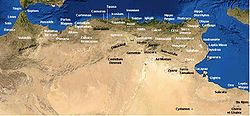
Téboursouk
Téboursouk is a town and commune in the Béja Governorate, Tunisia. As of 2004 it had a total population of 10,987.-References:...
, on a plateau with an uninhibited view of the surrounding plains in the Oued Khalled. The slope on which Dougga is built rises to the north and is bordered in the east by the cliff known as Kef Dougga. Further to the east, the ridge of the Fossa regia, a ditch realised by the Romans after the destruction of Carthage to mark the limits of the territory captured and incorporated into their empire and its distinction from the lands left to Numidians allied to Rome, are a testimony to Dougga’s position as a point of contact between the Punic and Berber
Berber people
Berbers are the indigenous peoples of North Africa west of the Nile Valley. They are continuously distributed from the Atlantic to the Siwa oasis, in Egypt, and from the Mediterranean to the Niger River. Historically they spoke the Berber language or varieties of it, which together form a branch...
worlds.
The site offers a high degree of natural protection, which helps to explain its early occupation.
History
Dougga's history is best known from the time of the Roman conquest, even though numerous pre-Roman monuments, including a necropolisNecropolis
A necropolis is a large cemetery or burial ground, usually including structural tombs. The word comes from the Greek νεκρόπολις - nekropolis, literally meaning "city of the dead"...
, the mausoleum
Mausoleum
A mausoleum is an external free-standing building constructed as a monument enclosing the interment space or burial chamber of a deceased person or persons. A monument without the interment is a cenotaph. A mausoleum may be considered a type of tomb or the tomb may be considered to be within the...
, and temple
Temple
A temple is a structure reserved for religious or spiritual activities, such as prayer and sacrifice, or analogous rites. A templum constituted a sacred precinct as defined by a priest, or augur. It has the same root as the word "template," a plan in preparation of the building that was marked out...
s have been discovered during archaeological digs. These monuments are an indication of the site's importance before the arrival of the Romans.
Origins
According to Gabriel CampsGabriel Camps
Gabriel Camps was a French historian, founder of the Encyclopédie berbère and considered a prestigious scholar in Berber historical studies.-Biography:Gabriel Camps was born in Misserghine...
, the Numidian name for the city is TBGG, which derives from the Libyan word TBG (to protect). This toponym evidently derives from the site's location atop an easily defensible plateau.
The city appears to have been founded in the 6th century BCE. Some historians believe that Dougga is the city of Tokaï, which was captured by a lieutenant of Agathocles
Agathocles
Agathocles , , was tyrant of Syracuse and king of Sicily .-Biography:...
at the end of the 4th century BCE; Diodorus Siculus
Diodorus Siculus
Diodorus Siculus was a Greek historian who flourished between 60 and 30 BC. According to Diodorus' own work, he was born at Agyrium in Sicily . With one exception, antiquity affords no further information about Diodorus' life and doings beyond what is to be found in his own work, Bibliotheca...
described that city as "a city of beautiful grandeur".
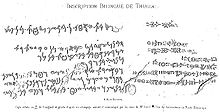
Dolmen
A dolmen—also known as a portal tomb, portal grave, dolmain , cromlech , anta , Hünengrab/Hünenbett , Adamra , Ispun , Hunebed , dös , goindol or quoit—is a type of single-chamber megalithic tomb, usually consisting of...
s, the most ancient archaeological find at Dougga, a sanctuary dedicated to Ba'al Hammon, neo-Punic stele
Stele
A stele , also stela , is a stone or wooden slab, generally taller than it is wide, erected for funerals or commemorative purposes, most usually decorated with the names and titles of the deceased or living — inscribed, carved in relief , or painted onto the slab...
s, the mausoleum, architectural fragments and a temple dedicated to Masinissa
Masinissa
Masinissa — also spelled Massinissa and Massena — was the first King of Numidia, an ancient North African nation of ancient Libyan tribes. As a successful general, Masinissa fought in the Second Punic War , first against the Romans as an ally of Carthage an later switching sides when he saw which...
, the remains of which were found during archaeological excavations. Even though our knowledge of the city before the Roman conquest remains very limited, recent archaeological finds have revolutionised the image that we had of this period.
The identification of the temple dedicated to Masinissa beneath the forum
Forum (Roman)
A forum was a public square in a Roman municipium, or any civitas, reserved primarily for the vending of goods; i.e., a marketplace, along with the buildings used for shops and the stoas used for open stalls...
disproved Louis Poinssot's theory that the Numidian city stood on the plateau but that it was separate from the newer Roman settlement. The temple, which was erected in the tenth year of Micipsa
Micipsa
Micipsa was the eldest legitimate son of Masinissa, the King of Numidia, in the Ancient Algerian Maghreb of North Africa. He became the King of Numidia.-Early life:...
's reign, 139 BCE, is 14 metres long and 6.3 metres wide. It proves that the area around the forum was already built upon before the arrival of the Roman colonists. A building dating to the 2nd century BCE has also been discovered nearby. Similarly, Dougga's mausoleum is not isolated but stands within an urban necropolis.
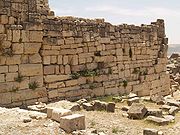
Late Antiquity
Late Antiquity is a periodization used by historians to describe the time of transition from Classical Antiquity to the Middle Ages, in both mainland Europe and the Mediterranean world. Precise boundaries for the period are a matter of debate, but noted historian of the period Peter Brown proposed...
. Targeted digs have also proven that what had been interpreted as two Numidian towers in the walls are in fact two funeral monuments from the Numidian era later reused much later as foundations and a section of defences.
The discovery of Libyan and Punic inscriptions at the site provoked a debate on the administration of the city at the time of the Kingdom of Numidia
Numidia
Numidia was an ancient Berber kingdom in part of present-day Eastern Algeria and Western Tunisia in North Africa. It is known today as the Chawi-land, the land of the Chawi people , the direct descendants of the historical Numidians or the Massyles The kingdom began as a sovereign state and later...
. The debate - about the interpretation of epigraphic
Epigraphy
Epigraphy Epigraphy Epigraphy (from the , literally "on-writing", is the study of inscriptions or epigraphs as writing; that is, the science of identifying the graphemes and of classifying their use as to cultural context and date, elucidating their meaning and assessing what conclusions can be...
sources - focussed on the question of whether the city was still under Punic influence or whether it was increasingly Berber. Local Berber institutions distinct from any form of Punic authority arose from the Numidian period onwards, but Gabriel Camps notes that Punic shofets were still in place in several cities, including Dougga, during the Roman era, which is a sign of continuing Punic influence and the preservation of certain elements of Punic civilisation well after the fall of Carthage.
Gradual integration of the city
The Romans granted Dougga the status of an indigenous city (civitas) following their conquest of the region.The creation of the colony of Carthage during the reign of Augustus
Augustus
Augustus ;23 September 63 BC – 19 August AD 14) is considered the first emperor of the Roman Empire, which he ruled alone from 27 BC until his death in 14 AD.The dates of his rule are contemporary dates; Augustus lived under two calendars, the Roman Republican until 45 BC, and the Julian...
complicated Dougga's institutional status. The city was included in the territory (pertica) of the Roman colony, but around this time, a pagus of Roman colonists also arose alongside the existing settlement. For two centuries, the site was thus governed by two civic and institutional bodies - the city with its peregrini
Peregrinus (Roman)
Peregrinus was the term used during the early Roman empire, from 30 BC to 212 AD, to denote a free provincial subject of the Empire who was not a Roman citizen. Peregrini constituted the vast majority of the Empire's inhabitants in the 1st and 2nd centuries AD...
and the pagus with its Roman citizens
Roman citizenship
Citizenship in ancient Rome was a privileged political and legal status afforded to certain free-born individuals with respect to laws, property, and governance....
, both of which had Roman civic institutions - magistrates and a council (ordo) of decurions
Decurion (administrative)
A decurion was a member of a city senate in the Roman Empire. Decurions were drawn from the curiales class, which was made up of the wealthy middle class citizens of a town society....
for the city, a local council from the end of the 1st century CE, and local administrators for the pagus, who were legally subordinated to the distant but powerful colony of Carthage.
Over time, the Romanisation
Romanization (cultural)
Romanization or latinization indicate different historical processes, such as acculturation, integration and assimilation of newly incorporated and peripheral populations by the Roman Republic and the later Roman Empire...
of the city brought the two communities closer together. Notable members of the peregrini increasingly adopted Roman culture and behaviour, became Roman citizens, and the councils of the two communities began to take decisions in unison. The increasing closeness of the communities was facilitated at first by their geographic proximity - there was no physical distinction between their two settlements - and then later by institutional arrangements. During the reign of Marcus Aurelius, the city was granted Roman law
Roman law
Roman law is the legal system of ancient Rome, and the legal developments which occurred before the 7th century AD — when the Roman–Byzantine state adopted Greek as the language of government. The development of Roman law comprises more than a thousand years of jurisprudence — from the Twelve...
; from this moment onward, the magistrates automatically received Roman citizenship and the rights of the city's inhabitants became similar to those of the Roman citizens. During the same era, the pagus won a certain degree of autonomy from Carthage; it was able to receive bequests and administer public funds.
Nonetheless, it was not until 205 CE, during the reign of Septimius Severus
Septimius Severus
Septimius Severus , also known as Severus, was Roman Emperor from 193 to 211. Severus was born in Leptis Magna in the province of Africa. As a young man he advanced through the customary succession of offices under the reigns of Marcus Aurelius and Commodus. Severus seized power after the death of...
, that the two communities came together as one municipium
Municipium
Municipium , the prototype of English municipality, was the Latin term for a town or city. Etymologically the municipium was a social contract between municipes, the "duty holders," or citizens of the town. The duties, or munera, were a communal obligation assumed by the municipes in exchange for...
, made “free” (see below) while Carthage’s pertica was reduced. The city was supported by the euergetism of its great families of wealthy individuals, which sometimes reached exorbitant levels, while its interests were successfully represented by appeals to the emperors
Roman Emperor
The Roman emperor was the ruler of the Roman State during the imperial period . The Romans had no single term for the office although at any given time, a given title was associated with the emperor...
. Dougga’s development culminated during the reign of Gallienus
Gallienus
Gallienus was Roman Emperor with his father Valerian from 253 to 260, and alone from 260 to 268. He took control of the Empire at a time when it was undergoing great crisis...
, when it obtained the status of a Roman colony
Colonia (Roman)
A Roman colonia was originally a Roman outpost established in conquered territory to secure it. Eventually, however, the term came to denote the highest status of Roman city.-History:...
with the title Colonia Licinia Septimia Aurelia Alexandriana Thuggensis. Dougga’s monuments attest to its prosperity in the period from the reign of Diocletian
Diocletian
Diocletian |latinized]] upon his accession to Diocletian . c. 22 December 244 – 3 December 311), was a Roman Emperor from 284 to 305....
to that of Theodosius I
Theodosius I
Theodosius I , also known as Theodosius the Great, was Roman Emperor from 379 to 395. Theodosius was the last emperor to rule over both the eastern and the western halves of the Roman Empire. During his reign, the Goths secured control of Illyricum after the Gothic War, establishing their homeland...
, but it fell into a sort of stupur from the 4th century CE; Christianity
Christianity
Christianity is a monotheistic religion based on the life and teachings of Jesus as presented in canonical gospels and other New Testament writings...
only left very minimal traces in the city.
Dougga’s “liberty”
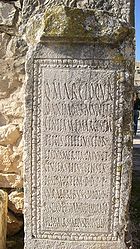
Septimium and Aurelium are references to the names of the municipium’s “founders” (conditores) (Septimius Severus
Septimius Severus
Septimius Severus , also known as Severus, was Roman Emperor from 193 to 211. Severus was born in Leptis Magna in the province of Africa. As a young man he advanced through the customary succession of offices under the reigns of Marcus Aurelius and Commodus. Severus seized power after the death of...
and Caracalla
Caracalla
Caracalla , was Roman emperor from 198 to 217. The eldest son of Septimius Severus, he ruled jointly with his younger brother Geta until he murdered the latter in 211...
, whose Latin title was Marcus Aurelius Antoninus); the granting of a new legal status to Dougga was equated to the foundation of a new city.
The significance of the term Liberum is not immediately clear. The term appears in the titles of a certain number of other municipia also founded at the same time: Thibursicum Bure
Téboursouk
Téboursouk is a town and commune in the Béja Governorate, Tunisia. As of 2004 it had a total population of 10,987.-References:...
, Aulodes and Thysdrus
El Djem
Drifting sand is preserving the market city of Thysdrus and the refined suburban villas that once surrounded it. The amphiteatre occupies archaeologists' attention: no digging required...
. Several interpretations of its meaning have been suggested. According to Alfred Merlin and Louis Poinssot, the term derives from the name of the god Liber
Liber
In ancient Roman religion and mythology, Liber , also known as Liber Pater was a god of viticulture and wine, fertility and freedom. He was a patron deity of Rome's plebeians and was part of their Aventine Triad. His festival of Liberalia became associated with free speech and the rights...
, in whose honour a temple was erected at Dougga. The epithet Liberum would thus follow the same pattern as Frugifer and Concordia, which appear in the title of Thibursicum Bure. Thibursicum Bure is however an exception to the rule; the titles of the other municipia including the term Liberum do not include the names of any divinities, and this hypothesis has therefore been abandoned. Liberum is thus a reference to libertas (liberty). This interpretation is confirmed by an inscription found at Dougga that honours Alexander Severus
Alexander Severus
Severus Alexander was Roman Emperor from 222 to 235. Alexander was the last emperor of the Severan dynasty. He succeeded his cousin Elagabalus upon the latter's assassination in 222, and was ultimately assassinated himself, marking the epoch event for the Crisis of the Third Century — nearly fifty...
as the conservator libertatis (the preserver of liberty).
It is however also unclear exactly what form this liberty took. Jules Toutain is of the opinion that this is a designation for a particular type of municipium - free cities where the Roman governor did not have the right to control the municipal magistrates. There is however no evidence that Dougga enjoyed exceptional legal privileges of the type associated with certain free cities such as Aphrodisias
Aphrodisias
Aphrodisias was a small city in Caria, on the southwest coast of Asia Minor. Its site is located near the modern village of Geyre, Turkey, about 230 km from İzmir....
in Asia Minor
Anatolia
Anatolia is a geographic and historical term denoting the westernmost protrusion of Asia, comprising the majority of the Republic of Turkey...
. Paul Veyne
Paul Veyne
Paul Veyne, born 13 June 1930 in Aix-en-Provence, is a French archaeologist and historian, and a specialist on Ancient Rome. A former student of the École normale supérieure and member of the École française de Rome, he is now honorary professor at the Collège de France.-Biography:From an ordinary...
has thus suggested that Dougga’s libertas is nothing but an expression of the concept of liberty without any legal meaning; obtaining the status of a municipium had freed the city of its subjugation and enabled it to adorn itself with the ornamenta libertatis. The city’s liberty was celebrated just as its dignity was extolled; Emperor Probus is conservator libertatis et dignitatis (the preserver of liberty and dignity). Jacques Gascou, in line with Paul Veyne’s interpretation, describes the situation thus: “Liberum, in Thugga’s title, is a term […] with which the city, which had waited a long time for the status of a municipium, is happy to flatter itself”.
Despite Gascou’s conclusion, efforts have been made more recently to identify concrete aspects of Dougga’s liberty. Claude Lepelley believes on the one hand that this must be a reference to the relations between the city and Rome
Rome
Rome is the capital of Italy and the country's largest and most populated city and comune, with over 2.7 million residents in . The city is located in the central-western portion of the Italian Peninsula, on the Tiber River within the Lazio region of Italy.Rome's history spans two and a half...
and on the other hand that the term can cover a range of diverse privileges of differing degrees. It is known that the territory of Carthage, to which the Dougga pagus belonged until 205 CE, enjoyed such privileges: the inhabitants of the pagus even sent an appeal during Trajan
Trajan
Trajan , was Roman Emperor from 98 to 117 AD. Born into a non-patrician family in the province of Hispania Baetica, in Spain Trajan rose to prominence during the reign of emperor Domitian. Serving as a legatus legionis in Hispania Tarraconensis, in Spain, in 89 Trajan supported the emperor against...
’s reign to defend the immunitas perticae Carthaginiensium, the (fiscal) immunity of the territory of Carthage. The Dougga civitas had not been granted this concession, and the fusion of pagus with the civitas meant that the citizens of the pagus risked losing their enviable privilege. The liberty of the municipia founded during the reign of Septimius Severus
Septimius Severus
Septimius Severus , also known as Severus, was Roman Emperor from 193 to 211. Severus was born in Leptis Magna in the province of Africa. As a young man he advanced through the customary succession of offices under the reigns of Marcus Aurelius and Commodus. Severus seized power after the death of...
could thus be a reference to the fiscal immunity made possible by and the region’s great wealth and by the emperor’s generosity to each municipium at the time of its fusion. During the reign of Gallienus
Gallienus
Gallienus was Roman Emperor with his father Valerian from 253 to 260, and alone from 260 to 268. He took control of the Empire at a time when it was undergoing great crisis...
, a certain Aulus Vitellius Felix Honoratus, a well-known individual in Dougga, made an appeal to the emperor “in order to assure the public liberty”. Claude Lepelley believes that this is an indication that the city’s privilege had been called into question, although Dougga appears to have been at least partially able to preserve its concessions, as evidenced by an inscription to the honour of “Probus, defender of its liberty”.
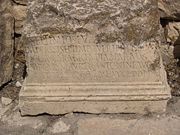
Commodus
Commodus , was Roman Emperor from 180 to 192. He also ruled as co-emperor with his father Marcus Aurelius from 177 until his father's death in 180. His name changed throughout his reign; see changes of name for earlier and later forms. His accession as emperor was the first time a son had succeeded...
(conservator pagi, protector of the pagus) '.
For Michel Christol, the term Liberum must be understood in this context and in an abstract sense. This liberty derives from belonging to a city and expresses the end of the civitas’ dependence, “the elevation of a community of peregrini to the liberty of Roman citizenship”, which also served to placate the fears of the inhabitants of the pagus and to open the door to a later promotion, to the status of a colony. This promotion took place in 261 CE, during the reign of Gallienus, following an appeal from Aulus Vitellius Felix Honoratus in Michel Christol’s version of events. Thereafter, the defence of the libertas publica was not a question of defending a privilege at risk, but of requesting the “ultimate liberty” (summa libertas) - the promotion to the status of a colony. Michel Christol also points out the abstract character of terms such as libertas or dignitas; despite their abstract use, they are references to concrete and unique events.
General layout
The city as it exists today consists essentially of remains from the Roman era dating for the most part to the 2nd and 3rd century CE. The Roman builders had to take account both of the site’s particularly craggy terrain and of earlier constructions, which led them to abandon the normal layout of Roman settlements, as is also particularly evident in places such as TimgadTimgad
Timgad , called Thamugas or Tamugadi in old Berber) was a Roman colonial town in the Aures mountain- numidia Algeria founded by the Emperor Trajan around 100 AD. The full name of the town was Colonia Marciana Ulpia Traiana Thamugadi...
.
Recent archaeological digs have confirmed the continuity in the city’s urban development. The heart of the city has always been at the top of the hill, where the forum replaced the Numidian agora
Agora
The Agora was an open "place of assembly" in ancient Greek city-states. Early in Greek history , free-born male land-owners who were citizens would gather in the Agora for military duty or to hear statements of the ruling king or council. Later, the Agora also served as a marketplace where...
. As Dougga developed, urban construction occupied the side of the hill, so that the city must have resembled “a compact mass”, according to Hédi Slim
Early archaeological digs concentrated on public buildings, which meant that private buildings tended at first to be uncovered at the ends of the trenches dug for this purpose. Later, trenches were cut with the purpose of exposing particularly characteristic private buildings.
Numidian residence
Traces of a residence dating to the Numidian era have been identified in the foundations of the temple dedicated to LiberLiber
In ancient Roman religion and mythology, Liber , also known as Liber Pater was a god of viticulture and wine, fertility and freedom. He was a patron deity of Rome's plebeians and was part of their Aventine Triad. His festival of Liberalia became associated with free speech and the rights...
. Although these traces are very faint, they served to disprove the theories of the first archaeologists, including Louis Poinssot, that the Roman and pre-Roman settlements were located on separate sites. The two settlements evidently overlapped.
The trifolium villa
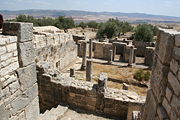
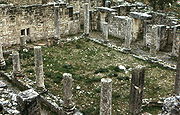
The trifolium villa, named after a clover
Clover
Clover , or trefoil, is a genus of about 300 species of plants in the leguminous pea family Fabaceae. The genus has a cosmopolitan distribution; the highest diversity is found in the temperate Northern Hemisphere, but many species also occur in South America and Africa, including at high altitudes...
-shaped room that was without a doubt used as a triclinium
Triclinium
A triclinium is a formal dining room in a Roman building. The word is adopted from the Greek τρικλίνιον, triklinion, from τρι-, tri-, "three", and κλίνη, klinē, a sort of "couch" or rather chaise longue...
, is the largest private house excavated so far at Dougga. The house had two storeys, but there is almost nothing left of the upper storey. It stands in the south of the city, halfway up the hill. The house is particularly interesting because of the way in which it is built to align with the lay of the land; the entrance hall slopes down to a courtyard around which the various rooms were arranged.
The market
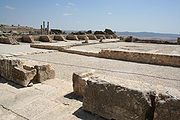
Portico
A portico is a porch leading to the entrance of a building, or extended as a colonnade, with a roof structure over a walkway, supported by columns or enclosed by walls...
and shops on two sides. The northern side had a portico, while an exedra
Exedra
In architecture, an exedra is a semicircular recess or plinth, often crowned by a semi-dome, which is sometimes set into a building's facade. The original Greek sense was applied to a room that opened onto a stoa, ringed with curved high-backed stone benches, a suitable place for a philosophical...
occupied the southern side. The exedra probably housed a statue of Mercury
Mercury (mythology)
Mercury was a messenger who wore winged sandals, and a god of trade, the son of Maia Maiestas and Jupiter in Roman mythology. His name is related to the Latin word merx , mercari , and merces...
.
In order to compensate for the natural incline of the ground on which the market stands, its builders undertook significant earthworks. These earthworks have been dated as being amongst the oldest Roman constructions, and their orientation vis-à-vis the forum seems to suggest that they were not built on any earlier foundations. The modern-day location of the remains from the market near the forum should however not be misunderstood as indicating a link between the two. The market was almost completely destroyed during the construction of the Byzantine fort. It was excavated in 1918-1919.
Licinian Baths
The Licinian Baths are quite interesting for having much of its original walls intact, as well as a long tunnel used by the slaves working at the baths. Also, from the baths are some fine views over the valley beyond.
The baths were donated to the city by the Licinii family in the 3rd century. They were primarily used as winter baths.
Look especially out for the frigidarium which has triple arcades at both ends and large windows with great views over the valley.
Dolmens
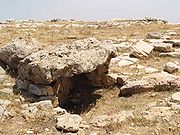
Dolmen
A dolmen—also known as a portal tomb, portal grave, dolmain , cromlech , anta , Hünengrab/Hünenbett , Adamra , Ispun , Hunebed , dös , goindol or quoit—is a type of single-chamber megalithic tomb, usually consisting of...
s in North Africa
North Africa
North Africa or Northern Africa is the northernmost region of the African continent, linked by the Sahara to Sub-Saharan Africa. Geopolitically, the United Nations definition of Northern Africa includes eight countries or territories; Algeria, Egypt, Libya, Morocco, South Sudan, Sudan, Tunisia, and...
has served to stoke historiographic debates that are not without ideological agendas. The dolmens at Dougga have been the subject of archaeological digs, which have also uncovered skeletons and ceramic models.
Although it is difficult to put a date on the erection of the dolmens, as they were in use until the dawn of the Christian era, it seems likely that they date from at least 2000 years BCE. Gabriel Camps
Gabriel Camps
Gabriel Camps was a French historian, founder of the Encyclopédie berbère and considered a prestigious scholar in Berber historical studies.-Biography:Gabriel Camps was born in Misserghine...
has suggested that a link to Sicily
Sicily
Sicily is a region of Italy, and is the largest island in the Mediterranean Sea. Along with the surrounding minor islands, it constitutes an autonomous region of Italy, the Regione Autonoma Siciliana Sicily has a rich and unique culture, especially with regard to the arts, music, literature,...
. He has made the same suggestion for the “haouanet” tombs found in Algeria
Algeria
Algeria , officially the People's Democratic Republic of Algeria , also formally referred to as the Democratic and Popular Republic of Algeria, is a country in the Maghreb region of Northwest Africa with Algiers as its capital.In terms of land area, it is the largest country in Africa and the Arab...
and Tunisia
Tunisia
Tunisia , officially the Tunisian RepublicThe long name of Tunisia in other languages used in the country is: , is the northernmost country in Africa. It is a Maghreb country and is bordered by Algeria to the west, Libya to the southeast, and the Mediterranean Sea to the north and east. Its area...
.
Numidian bazina tombs
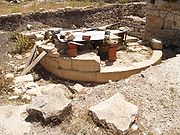
Punic-Libyan Mausoleum
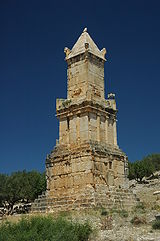
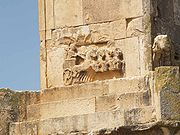
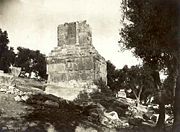
Sabratha
Sabratha, Sabratah or Siburata , in the Zawiya District in the northwestern corner of modern Libya, was the westernmost of the "three cities" of Tripolis. From 2001 to 2007 it was the capital of the former Sabratha wa Sorman District. It lies on the Mediterranean coast about west of Tripoli...
in Libya
Libya
Libya is an African country in the Maghreb region of North Africa bordered by the Mediterranean Sea to the north, Egypt to the east, Sudan to the southeast, Chad and Niger to the south, and Algeria and Tunisia to the west....
. Some authors believe that there is a link with the funeral architecture in Anatolia
Anatolia
Anatolia is a geographic and historical term denoting the westernmost protrusion of Asia, comprising the majority of the Republic of Turkey...
and the necropolises in Alexandria
Alexandria
Alexandria is the second-largest city of Egypt, with a population of 4.1 million, extending about along the coast of the Mediterranean Sea in the north central part of the country; it is also the largest city lying directly on the Mediterranean coast. It is Egypt's largest seaport, serving...
from the 3rd and 2nd century BCE.
This tomb is 21 metres tall and was built in the 2nd century BCE. An inscription that has been preserved from the tomb had been understood as an indication that the tomb was dedicated to Atban, the son of Iepmatath and Palu. In 1842, Sir Thomas Read, the British
United Kingdom
The United Kingdom of Great Britain and Northern IrelandIn the United Kingdom and Dependencies, other languages have been officially recognised as legitimate autochthonous languages under the European Charter for Regional or Minority Languages...
consul
Consul (representative)
The political title Consul is used for the official representatives of the government of one state in the territory of another, normally acting to assist and protect the citizens of the consul's own country, and to facilitate trade and friendship between the peoples of the two countries...
in Tunis
Tunis
Tunis is the capital of both the Tunisian Republic and the Tunis Governorate. It is Tunisia's largest city, with a population of 728,453 as of 2004; the greater metropolitan area holds some 2,412,500 inhabitants....
seriously damaged the monument while removing this inscription. It has only recently been established that the inscription was originally located on one side of a fake window on the podium
Podium
A podium is a platform that is used to raise something to a short distance above its surroundings. It derives from the Greek πόδι In architecture a building can rest on a large podium. Podia can also be used to raise people, for instance the conductor of an orchestra stands on a podium as do many...
. According to the most recent research, the names cited in the inscription are only those of its architect and of representatives of the different professions involved in its construction. The monument was built by the inhabitants of the city for a Numidian prince; some authors believe that it was intended for Massinissa.
Another bilingual Libyan
Berber languages
The Berber languages are a family of languages indigenous to North Africa, spoken from Siwa Oasis in Egypt to Morocco , and south to the countries of the Sahara Desert...
and Punic
Punic language
The Punic language or Carthagian language is an extinct Semitic language formerly spoken in the Mediterranean region of North Africa and several Mediterranean islands, by people of the Punic culture.- Description :...
inscription which is now held at the British Museum
British Museum
The British Museum is a museum of human history and culture in London. Its collections, which number more than seven million objects, are amongst the largest and most comprehensive in the world and originate from all continents, illustrating and documenting the story of human culture from its...
made it possible to decode the Libyan characters. The monument owes its current appearance to the work of French
French people
The French are a nation that share a common French culture and speak the French language as a mother tongue. Historically, the French population are descended from peoples of Celtic, Latin and Germanic origin, and are today a mixture of several ethnic groups...
archaeologist Louis Poinssot, who essentially reconstructed it from pieces that were left lying on the ground.
The tomb is accessed via a pedestal
Pedestal
Pedestal is a term generally applied to the support of a statue or a vase....
with five steps. On the northern side of the podium (the lowest of three levels in the monument), there is an opening to the funeral chamber that is closed with a stone slab. The other sides are decorated with fake windows and four Aeolic
Aeolic order
The Aeolic order or Aeolian order was an early order of Classical architecture.The form developed in northwestern Asia Minor, but is also seen in some temples in Sicily, and is named for the Aeolian Islands. It has a strong similarity to the better known Ionic order, but differs in the capital,...
pilaster
Pilaster
A pilaster is a slightly-projecting column built into or applied to the face of a wall. Most commonly flattened or rectangular in form, pilasters can also take a half-round form or the shape of any type of column, including tortile....
s. The second level is made up of a temple-like colonnade (naiskos); the columns on each side are Ionic
Ionic order
The Ionic order forms one of the three orders or organizational systems of classical architecture, the other two canonic orders being the Doric and the Corinthian...
. The third level is the most richly decorated of all: in addition to pilasters similar to those on the lowest level, it is capped with a pyramid
Pyramid
A pyramid is a structure whose outer surfaces are triangular and converge at a single point. The base of a pyramid can be trilateral, quadrilateral, or any polygon shape, meaning that a pyramid has at least three triangular surfaces...
. Some elements of carved stone have also survived.
Roman sepulchres
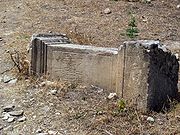
Olive Tree
The Olive Tree was a denomination used for several successive centre-left Italian political coalitions from 1995 to 2007.The historical leader and ideologue of these coalitions was Romano Prodi, Professor of Economics and former leftist Christian Democrat, who invented the name and the symbol of...
s.
The different necropolises mark the zones of settlement at Dougga. There are five areas that have been identified as necropolises: the first in the northeast, around the Temple of Saturn and the Victoria Church, the second in the northwest, a zone which also encompasses the dolmens on the site, the third in the west, between the Aïn Mizeb and Aïn El Hammam cisterns and to the north of the Temple of Juno Caelestis, the fourth and the fifth in the south and the south-east, one around the mausoleum and the other around Septimius Severus’ triumphal arch
Triumphal arch
A triumphal arch is a monumental structure in the shape of an archway with one or more arched passageways, often designed to span a road. In its simplest form a triumphal arch consists of two massive piers connected by an arch, crowned with a flat entablature or attic on which a statue might be...
.
Hypogeum

Hypogeum
Hypogeum or hypogaeum literally means "underground", from Greek hypo and gaia . It usually refers to an underground, non-Christian temple or a tomb...
is a half-buried edifice from the 3rd century CE. It was erected in the middle of the oldest necropolis, which was excavated in 1913. The hypogeum was designed to house funeral urns in small niches in the walls; at the time of its discovery, it contained sarcophagi
Sarcophagus
A sarcophagus is a funeral receptacle for a corpse, most commonly carved or cut from stone. The word "sarcophagus" comes from the Greek σαρξ sarx meaning "flesh", and φαγειν phagein meaning "to eat", hence sarkophagus means "flesh-eating"; from the phrase lithos sarkophagos...
, which suggests that it was in use for a long time.
Triumphal arches
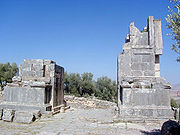
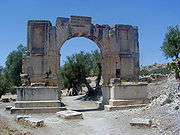
Triumphal arch
A triumphal arch is a monumental structure in the shape of an archway with one or more arched passageways, often designed to span a road. In its simplest form a triumphal arch consists of two massive piers connected by an arch, crowned with a flat entablature or attic on which a statue might be...
es, which are in different states of disrepair.
Septimius Severus
Septimius Severus
Septimius Severus , also known as Severus, was Roman Emperor from 193 to 211. Severus was born in Leptis Magna in the province of Africa. As a young man he advanced through the customary succession of offices under the reigns of Marcus Aurelius and Commodus. Severus seized power after the death of...
’s arch, which is heavily damaged, stands close to the mausoleum and on the route leading from Carthage to Théveste
Tébessa
Tébessa is the capital city of Tébessa Province, Algeria, 20 kilometers west from the border with Tunisia. Nearby is also a phosphate mine. The city is famous for the traditional Algerian carpets in the region, and is home to over 161,440 people.-History:...
. It was erected in 205 CE.
Alexander Severus
Alexander Severus
Severus Alexander was Roman Emperor from 222 to 235. Alexander was the last emperor of the Severan dynasty. He succeeded his cousin Elagabalus upon the latter's assassination in 222, and was ultimately assassinated himself, marking the epoch event for the Crisis of the Third Century — nearly fifty...
’s arch, which dates from 222-235, is relatively well preserved, despite the loss of its upper elements. It is equidistant from the capitol and the Temple of Juno Caelestis. Its arcade is four metres tall.
A third triumphal arch, dating from the Tetrarchy
Tetrarchy
The term Tetrarchy describes any system of government where power is divided among four individuals, but usually refers to the tetrarchy instituted by Roman Emperor Diocletian in 293, marking the end of the Crisis of the Third Century and the recovery of the Roman Empire...
, has been completely lost.
Forum
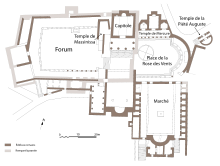
Portico
A portico is a porch leading to the entrance of a building, or extended as a colonnade, with a roof structure over a walkway, supported by columns or enclosed by walls...
s, dominates its surroundings by virtue of its imposing appearance. The “square of the Rose of the Winds” (which is named after a decorative element) seems more like an esplanade leading to the Temple of Mercury
Mercury (mythology)
Mercury was a messenger who wore winged sandals, and a god of trade, the son of Maia Maiestas and Jupiter in Roman mythology. His name is related to the Latin word merx , mercari , and merces...
, which stands on its northern side, than an open public space. The city’s curia
Curia
A curia in early Roman times was a subdivision of the people, i.e. more or less a tribe, and with a metonymy it came to mean also the meeting place where the tribe discussed its affairs...
and a tribune for speeches probably also stood here.
Long ago, archaeologists believed that Roman settlement at Dougga occurred ex nihilo
Ex nihilo
Ex nihilo is a Latin phrase meaning "out of nothing". It often appears in conjunction with the concept of creation, as in creatio ex nihilo, meaning "creation out of nothing"—chiefly in philosophical or theological contexts, but also occurs in other fields.In theology, the common phrase creatio ex...
. This suggestion has been contradicted by the discovery of a sanctuary dedicated to Massinissa amongst the substructures to the rear of the capitol.
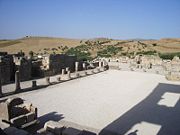
Theatre
Theatres were a fundamental element of the monumental make-up of a city from the reign of AugustusAugustus
Augustus ;23 September 63 BC – 19 August AD 14) is considered the first emperor of the Roman Empire, which he ruled alone from 27 BC until his death in 14 AD.The dates of his rule are contemporary dates; Augustus lived under two calendars, the Roman Republican until 45 BC, and the Julian...
.
The theatre
Roman theatre
Roman theatre may refer to:*Theatre of ancient Rome, the theatrical styles of Ancient Rome*Roman theatre , the theatre buildings of Ancient Rome...
, which was built in 168 or 169 CE, is one of the best preserved examples in Roman Africa
Roman Africa
Roman Africa may mean:*the Roman Africa province*the history of Africa during the Roman era, see North Africa during Antiquity#Roman era...
. It could seat 3500 spectators, even though Dougga only had 5000 inhabitants. It was one of a series of imperial buildings constructed over the course of two centuries at Dougga which deviate from the classic “blueprint
Blueprint
A blueprint is a type of paper-based reproduction usually of a technical drawing, documenting an architecture or an engineering design. More generally, the term "blueprint" has come to be used to refer to any detailed plan....
s” only inasmuch as they have been adapted to take account of the local terrain. Some minor adjustments have been made and the local architects had a certain freedom with regard to the ornamentation of the buildings.
A dedication engraved into the pediment
Pediment
A pediment is a classical architectural element consisting of the triangular section found above the horizontal structure , typically supported by columns. The gable end of the pediment is surrounded by the cornice moulding...
of the stage
Stage (theatre)
In theatre or performance arts, the stage is a designated space for the performance productions. The stage serves as a space for actors or performers and a focal point for the members of the audience...
and on the portico
Portico
A portico is a porch leading to the entrance of a building, or extended as a colonnade, with a roof structure over a walkway, supported by columns or enclosed by walls...
the dominates the city, recalls the building’s commissioner, P. Marcius Quadratus, who “built [it] for his homeland with his own denarii
Denarius
In the Roman currency system, the denarius was a small silver coin first minted in 211 BC. It was the most common coin produced for circulation but was slowly debased until its replacement by the antoninianus...
”; the dedication was celebrated with “scenic representations, distributions of life, a festival and athletic games”.
The theatre is still used for performances of classic theatre, particularly during the festival of Dougga, and conservation work has been carried out on it.
Auditorium
The site known as the auditorium is an annex of the Temple of LiberLiber
In ancient Roman religion and mythology, Liber , also known as Liber Pater was a god of viticulture and wine, fertility and freedom. He was a patron deity of Rome's plebeians and was part of their Aventine Triad. His festival of Liberalia became associated with free speech and the rights...
, which probably served for the initiation of novices. Despite its modern appellation, the auditorium was not a site for spectacles; only its form suggests otherwise. It measures 20 by 20.
Circus
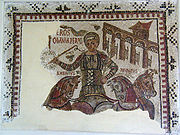
Circus (building)
The Roman circus was a large open-air venue used for public events in the ancient Roman Empire. The circuses were similar to the ancient Greek hippodromes, although serving varying purposes. Along with theatres and amphitheatres, Circuses were one of the main entertainment sites of the time...
designed for chariot racing
Chariot racing
Chariot racing was one of the most popular ancient Greek, Roman and Byzantine sports. Chariot racing was often dangerous to both driver and horse as they frequently suffered serious injury and even death, but generated strong spectator enthusiasm...
, but it is barely visible nowadays. Originally, the circus consisted of nothing more than a field; an inscription in the temple in honour of Caracalla’s victory in Germany notes that the land was donated by the Gabinii in 214 and describes it as an ager qui appellatur circus (field that serves as a circus) ). In 225 though, the site was prepared and the circus was constructed. It was financed by the magistrates (duumviri and aedile
Aedile
Aedile was an office of the Roman Republic. Based in Rome, the aediles were responsible for maintenance of public buildings and regulation of public festivals. They also had powers to enforce public order. There were two pairs of aediles. Two aediles were from the ranks of plebeians and the other...
) after they had promised to do so following in response to a request from the entire population of the city. The circus was built to take the maximum possible advantage of the surrounding landscape, in reflection of an understandable need to limit costs in a medium-sized city with limited resources, but certainly also out of desire to finish the construction works as quickly as possible, given that magistrates’ mandates were limited to one year. The construction was nonetheless expected to have “a certain magnitude”; at 393 metres long with a spina
Spina
Spina was an Etruscan port city, established by the end of the 6th c. BCE, on the Adriatic at the ancient mouth of the Po, south of the lagoon which would become the site of Venice...
190 metres long and 6 metres wide, the circus is quite extraordinary in Roman Africa
Roman Africa
Roman Africa may mean:*the Roman Africa province*the history of Africa during the Roman era, see North Africa during Antiquity#Roman era...
. The circus marks Dougga out as one of the most important cities in the province, alongside Carthage
Carthage
Carthage , implying it was a 'new Tyre') is a major urban centre that has existed for nearly 3,000 years on the Gulf of Tunis, developing from a Phoenician colony of the 1st millennium BC...
, Thysdrus
El Djem
Drifting sand is preserving the market city of Thysdrus and the refined suburban villas that once surrounded it. The amphiteatre occupies archaeologists' attention: no digging required...
, Leptis Magna
Leptis Magna
Leptis Magna also known as Lectis Magna , also called Lpqy, Neapolis, Lebida or Lebda to modern-day residents of Libya, was a prominent city of the Roman Empire. Its ruins are located in Khoms, Libya, east of Tripoli, on the coast where the Wadi Lebda meets the sea...
, Hadrumet et Utica
Utica, Tunisia
Utica is an ancient city northwest of Carthage near the outflow of the Medjerda River into the Mediterranean Sea, traditionally considered to be the first colony founded by the Phoenicians in North Africa...
. The donation of the land for the pleasure of the general populace (ad voluptatem populi) and its development following a request from the entire population (postulante universo populo) are a reminder of the importance of spectacles in the social life of Roman cities and the demand for popular entertainment.
Amphitheatre
The question of whether there was an amphitheatreRoman amphitheatre
Roman amphitheatres are amphitheatres – large, circular or oval open-air venues with raised seating – built by the Ancient Romans. They were used for events such as gladiator combats, chariot races, venationes and executions. About 230 Roman amphitheatres have been found across the area of the...
at Dougga has not been conclusively answered. Traditionally, a large elliptic depression to the northwest of the site has been interpreted as the site of an amphitheatre. Archeologists have however become much more cautious on this subject.
Baths
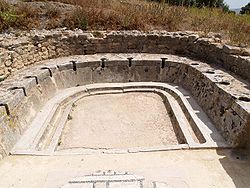
Thermae
In ancient Rome, thermae and balnea were facilities for bathing...
have been completely excavated at Dougga; a fourth has so far only been partially uncovered. Of these four baths, one (“the bath of the house to the west of the Temple of Tellus”) belongs to a private residence, two, the Aïn Doura bath and the bath known for a long time as the “Licinian bath”, were, judging by their size, open to the public, while the nature of the last bath, the bath of the Cyclopses, is more difficult to interpret.
Bath of the Cyclopses
During the excavation of the Bath of the CyclopsCyclops
A cyclops , in Greek mythology and later Roman mythology, was a member of a primordial race of giants, each with a single eye in the middle of his forehead...
es, a mosaic
Mosaic
Mosaic is the art of creating images with an assemblage of small pieces of colored glass, stone, or other materials. It may be a technique of decorative art, an aspect of interior decoration, or of cultural and spiritual significance as in a cathedral...
of cyclopses forging Jupiter’s thunderbolts was uncovered. It is now on display at the Bardo National Museum, where several very well preserved latrines
Sanitation in Ancient Rome
Sanitation in ancient Rome was a complex system similar in many ways to modern sanitation systems. During the Dark Ages, the technical knowledge of the system was lost and has subsequently been investigated by modern-era historians and archeologists....
are also on display. The building has been dated to the 3rd century CE on the basis of a study of the mosaic.
The size of the building (its frigidarium
Frigidarium
A frigidarium is a large cold pool of Roman baths. It would be entered after the Caldarium and the Tepidarium, which were used to open the pores of the skin. The cold water would close the pores. There would be a small pool of cold water or sometimes a large Swimming pool...
is less than 30 m²) has led some experts to believe that it was a private bath, but the identification of a domus
Domus
In ancient Rome, the domus was the type of house occupied by the upper classes and some wealthy freedmen during the Republican and Imperial eras. They could be found in almost all the major cities throughout the Roman territories...
in the immediate vicinity has proven difficult. The “trifolium villa” is quite distant, and the closest ruins are hard to identify as they have not been well preserved. Yvon Thébert therefore suggests that the bath served the local quarter.
Antonian or Licinian Bath

Gallienus
Gallienus was Roman Emperor with his father Valerian from 253 to 260, and alone from 260 to 268. He took control of the Empire at a time when it was undergoing great crisis...
’ reign on the basis of incomplete inscriptions and Dougga’s prosperity at this time has been called into question by recent research, conducted in particular by Michel Christol. Christol has suggested that the bath dates from the reign of Caracalla
Caracalla
Caracalla , was Roman emperor from 198 to 217. The eldest son of Septimius Severus, he ruled jointly with his younger brother Geta until he murdered the latter in 211...
; this thesis has since been confirmed by an anlysis of inscriptions
Epigraphy
Epigraphy Epigraphy Epigraphy (from the , literally "on-writing", is the study of inscriptions or epigraphs as writing; that is, the science of identifying the graphemes and of classifying their use as to cultural context and date, elucidating their meaning and assessing what conclusions can be...
. Others have even suggested that the bath dates from the reign of the Severan dynasty
Severan dynasty
The Severan dynasty was a Roman imperial dynasty, which ruled the Roman Empire between 193 and 235. The dynasty was founded by the Roman general Septimius Severus, who rose to power during the civil war of 193, known as the Year of the Five Emperors....
, because of a particularity which became common a century later in the west: the columns in the northwest peristyle
Peristyle
In Hellenistic Greek and Roman architecture a peristyle is a columned porch or open colonnade in a building surrounding a court that may contain an internal garden. Tetrastoon is another name for this feature...
feature dais
Dais
Dais is any raised platform located either in or outside of a room or enclosure, often for dignified occupancy, as at the front of a lecture hall or sanctuary....
es bearing arches.
The bath was later used for the production of olive oil
Olive oil
Olive oil is an oil obtained from the olive , a traditional tree crop of the Mediterranean Basin. It is commonly used in cooking, cosmetics, pharmaceuticals, and soaps and as a fuel for traditional oil lamps...
at an unknown date.
The symmetrical building is medium-sized, with an area of 1700 m² excluding the palaestra
Palaestra
The palaestra was the ancient Greek wrestling school. The events that did not require a lot of space, such as boxing and wrestling, were practised there...
, of which 175 m² are taken up by the frigidarium. The construction of the bath required work both to lower and to raise sections of the slope on which it stood, which may explain why parts of the building have been better preserved than others; the section built on raised ground has for the most part been lost.
Aïn Doura Bath
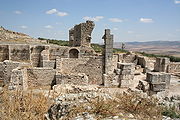
The complex remains largely unexposed, but it seems, according to Yvon Thébert, that it has a symmetrical design, of which only a section of the cold rooms has been excavated.
The bath of the house to the west of the Temple of Tellus
This bath, measuring 75 m², which can be accessed from the house and from the street, was uncovered at the start of the 20th century. The archaeological analysis of the bath’s relationship with the house in which it is located has led Yvon Thébert to suggest that it was a later addition to the original construction but he does not propose a date for this event.Religious edifices
There is archaeological or epigraphicEpigraphy
Epigraphy Epigraphy Epigraphy (from the , literally "on-writing", is the study of inscriptions or epigraphs as writing; that is, the science of identifying the graphemes and of classifying their use as to cultural context and date, elucidating their meaning and assessing what conclusions can be...
evidence for more than twenty temples at Dougga; a significant number for a small city. There are archaeological remains and inscriptions proving the existence of eleven temples, archaeological remains of a further eight, and inscriptions referring to another fourteen. This abundance of religious sites is the result in particular of the philanthropy of wealthy families.
Temple of Massinissa
The Temple of Massinissa is located on the western flank of the capital. The first archaeologists believed that the remains of the temple were a monumental fountainFountain
A fountain is a piece of architecture which pours water into a basin or jets it into the air either to supply drinking water or for decorative or dramatic effect....
, even though an inscription proving the existence of a sanctuary to the deceased Numidia
Numidia
Numidia was an ancient Berber kingdom in part of present-day Eastern Algeria and Western Tunisia in North Africa. It is known today as the Chawi-land, the land of the Chawi people , the direct descendants of the historical Numidians or the Massyles The kingdom began as a sovereign state and later...
n king was discovered in 1904. This inscription has been dated to 139 BCE, during the reign of Micipsa
Micipsa
Micipsa was the eldest legitimate son of Masinissa, the King of Numidia, in the Ancient Algerian Maghreb of North Africa. He became the King of Numidia.-Early life:...
.
The remains are similar to those of the temple in Chemtou
Chemtou
Chemtou or Chimtou is an ancient site in northwestern Tunisia, located 20 km from the city of Jendouba, near the Algerian border.Ancient Simitthu is known for its important marble quarries which were exploited from the 2nd century BC.The Chemtou Museum displays artifacts discovered in the...
and are evidence of the fact that the political centre of the Roman city was in the same place as the Hellenic agora
Agora
The Agora was an open "place of assembly" in ancient Greek city-states. Early in Greek history , free-born male land-owners who were citizens would gather in the Agora for military duty or to hear statements of the ruling king or council. Later, the Agora also served as a marketplace where...
. The stone remains found in this area seem to belong to several different structures; the exact location of the sanctuary is still open to debate.
Although it is believed that the sanctuary set Massinissa on par with a god, this is debated by some experts. Stéphane Gsell believes that a temple to the king would reflect a continuation of eastern and Hellenic practices; Gabriel Camps
Gabriel Camps
Gabriel Camps was a French historian, founder of the Encyclopédie berbère and considered a prestigious scholar in Berber historical studies.-Biography:Gabriel Camps was born in Misserghine...
builds on this hypothesis, pointing out the lack of any antique sources testifying to anything more than simple expressions of respect by a people vis-à-vis its king. According to Camps, the temple is only a memorial, a site belonging to a funeral cult. Its construction ten years into Micipsa
Micipsa
Micipsa was the eldest legitimate son of Masinissa, the King of Numidia, in the Ancient Algerian Maghreb of North Africa. He became the King of Numidia.-Early life:...
’s reign can be explained by its political symbolism: Micipsa, sole ruler after the death of his brothers Gulussa and Mastanabal, was affirming the unity of his kingdom around the person of the king.
The capitol
The capitol is a Roman temple from the 2nd century CE, principally dedicated to RomeRome
Rome is the capital of Italy and the country's largest and most populated city and comune, with over 2.7 million residents in . The city is located in the central-western portion of the Italian Peninsula, on the Tiber River within the Lazio region of Italy.Rome's history spans two and a half...
’s protective triad
Capitoline Triad
In ancient Roman religion, the Capitoline Triad was a group of three supreme deities who were worshipped in an elaborate temple on Rome's Capitoline Hill, the Capitolium. Two distinct Capitoline Triads were worshipped at various times in Rome's history, both originating in ancient traditions...
: Jupiter
Jupiter (mythology)
In ancient Roman religion and myth, Jupiter or Jove is the king of the gods, and the god of the sky and thunder. He is the equivalent of Zeus in the Greek pantheon....
Optimus Maximus, Juno
Juno (mythology)
Juno is an ancient Roman goddess, the protector and special counselor of the state. She is a daughter of Saturn and sister of the chief god Jupiter and the mother of Mars and Vulcan. Juno also looked after the women of Rome. Her Greek equivalent is Hera...
Regina et Minerva Augusta. It has a secondary dedication to the wellbeing of the emperors Lucius Verus
Lucius Verus
Lucius Verus , was Roman co-emperor with Marcus Aurelius, from 161 until his death.-Early life and career:Lucius Verus was the first born son to Avidia Plautia and Lucius Aelius Verus Caesar, the first adopted son and heir of Roman Emperor Hadrian . He was born and raised in Rome...
and Marcus Aurelius; judging by this reference, the capitol must have been completed in 166-167 CE.
Thomas d’Arcos identified the capitol as a temple of Jupiter in the 17th century. It was the object of further research at the end of the 19th century, led in particular by the doctor Louis Carton in 1893. The walls, executed in opus africanum
Opus africanum
Opus africanum is a form of ashlar masonry used in Carthaginian and ancient Roman architecture, characterized by pillars of vertical blocks of stone alternating with horizontal blocks, filled in with smaller blocks in between....
style, and the entablature
Entablature
An entablature refers to the superstructure of moldings and bands which lie horizontally above columns, resting on their capitals. Entablatures are major elements of classical architecture, and are commonly divided into the architrave , the frieze ,...
of the portico
Portico
A portico is a porch leading to the entrance of a building, or extended as a colonnade, with a roof structure over a walkway, supported by columns or enclosed by walls...
were restored between 1903 and 1910. Claude Poinssot discovered a crypt
Crypt
In architecture, a crypt is a stone chamber or vault beneath the floor of a burial vault possibly containing sarcophagi, coffins or relics....
beneath the cella
Cella
A cella or naos , is the inner chamber of a temple in classical architecture, or a shop facing the street in domestic Roman architecture...
in 1955. The most recent works were carried out by the Tunisian Institut national du patrimoine between 1994 and 1996.
The capitol is exceptionally well preserved, which is a consequence of its inclusion in the Byzantine fortification. A series of eleven stairs lead up to the front portico. The temple front’s Corinthian
Corinthian order
The Corinthian order is one of the three principal classical orders of ancient Greek and Roman architecture. The other two are the Doric and Ionic. When classical architecture was revived during the Renaissance, two more orders were added to the canon, the Tuscan order and the Composite order...
columns are eight metres tall, on top of which is the perfectly preserved pediment
Pediment
A pediment is a classical architectural element consisting of the triangular section found above the horizontal structure , typically supported by columns. The gable end of the pediment is surrounded by the cornice moulding...
. The pediment bears a depiction of emperor Antoninus Pius
Antoninus Pius
Antoninus Pius , also known as Antoninus, was Roman Emperor from 138 to 161. He was a member of the Nerva-Antonine dynasty and the Aurelii. He did not possess the sobriquet "Pius" until after his accession to the throne...
’s elevation to godhood. The emperor is being carried by an eagle
Eagle
Eagles are members of the bird family Accipitridae, and belong to several genera which are not necessarily closely related to each other. Most of the more than 60 species occur in Eurasia and Africa. Outside this area, just two species can be found in the United States and Canada, nine more in...
.
The base of the cella still features alcoves for three statues. The middle alcove houses a colossal statue of Jupiter.
The discovery of the head of a statue of Jupiter has led Claude Poinssot to suggest that the crypt dates from the period of Christianity’s triumph over the old religions. Sophie Saint-Amans does not exclude the possibility that the crypt was built at the same time as the Byzantine citadel, of which the forum and capitol formed the nerve centre.
The construction of the capitol at Dougga occurred at the same time as the construction of other monuments of the same type elsewhere in North Africa
North Africa
North Africa or Northern Africa is the northernmost region of the African continent, linked by the Sahara to Sub-Saharan Africa. Geopolitically, the United Nations definition of Northern Africa includes eight countries or territories; Algeria, Egypt, Libya, Morocco, South Sudan, Sudan, Tunisia, and...
, which Pierre Gros explains as a consequence of the greater proximity of the imperial cult
Imperial cult (ancient Rome)
The Imperial cult of ancient Rome identified emperors and some members of their families with the divinely sanctioned authority of the Roman State...
and the cult of Jupiter.
Near the capitol are the “square of the Rose of the Winds” – which is named after a compass rose that is engraved on the floor – and the remains of the Byzantine citadel, which reused a section of the ruins after the city’s decline.
Temple of Mercury
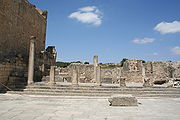
Mercury (mythology)
Mercury was a messenger who wore winged sandals, and a god of trade, the son of Maia Maiestas and Jupiter in Roman mythology. His name is related to the Latin word merx , mercari , and merces...
is also dedicated to Tellus
Tellus
Tellus is a Latin word meaning "earth" and may refer to:* Terra or Terra Mater, the Roman Earth Mother goddess* Tellus , a citizen of ancient Athens who was thought to be the happiest of men...
. It faces towards the market; between the two lies the “square of the Rose of the Winds”. The temple is largely in ruins. It has three cella
Cella
A cella or naos , is the inner chamber of a temple in classical architecture, or a shop facing the street in domestic Roman architecture...
e but no courtyard. The sanctuary, which can be accessed via a series of four stairs, stands on a faded podium. It was excavated and shored up between 1904 and 1908.
Temple of August Piety
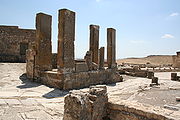
Hadrian
Hadrian , was Roman Emperor from 117 to 138. He is best known for building Hadrian's Wall, which marked the northern limit of Roman Britain. In Rome, he re-built the Pantheon and constructed the Temple of Venus and Roma. In addition to being emperor, Hadrian was a humanist and was philhellene in...
. It was financed through the philanthropy of a certain Caius Pompeius Nahanius. The temple faces the “square of the Rose of the Winds”. Part of the vestibule
Vestibule (architecture)
A vestibule is a lobby, entrance hall, or passage between the entrance and the interior of a building.The same term can apply to structures in modern or ancient roman architecture. In modern architecture vestibule typically refers to a small room or hall between an entrance and the interior of...
survives. Behind the temple, on the foundations of the Temple of Fortuna
Fortuna
Fortuna can mean:*Fortuna, the Roman goddess of luck -Geographical:*19 Fortuna, asteroid*Fortuna, California, town located on the north coast of California*Fortuna, United States Virgin Islands...
, Venus
Venus (mythology)
Venus is a Roman goddess principally associated with love, beauty, sex,sexual seduction and fertility, who played a key role in many Roman religious festivals and myths...
Concordia and Mercury
Mercury (mythology)
Mercury was a messenger who wore winged sandals, and a god of trade, the son of Maia Maiestas and Jupiter in Roman mythology. His name is related to the Latin word merx , mercari , and merces...
, stands a mosque
Mosque
A mosque is a place of worship for followers of Islam. The word is likely to have entered the English language through French , from Portuguese , from Spanish , and from Berber , ultimately originating in — . The Arabic word masjid literally means a place of prostration...
. The mosque is the last remnant of the little village that existed on the site until the creation of New Dougga.
Thomas d’Arcos identified the temple in 1631 thanks to an inscription that was still in situ at the time. The podium is relatively low (1-1.5 metres); it can be ascended by a series of seven stairs on the southern side.
Temple of Minerva

Patronage in ancient Rome
Patronage was the distinctive relationship in ancient Roman society between the patronus and his client . The relationship was hierarchical, but obligations were mutual. The patronus was the protector, sponsor, and benefactor of the client...
of the civitas at the end of the 1st century CE, but the more important site dedicated to this divinity is a building which features a temple and an area surrounded by a portico
Portico
A portico is a porch leading to the entrance of a building, or extended as a colonnade, with a roof structure over a walkway, supported by columns or enclosed by walls...
dating from the reign of Antoninus Pius
Antoninus Pius
Antoninus Pius , also known as Antoninus, was Roman Emperor from 138 to 161. He was a member of the Nerva-Antonine dynasty and the Aurelii. He did not possess the sobriquet "Pius" until after his accession to the throne...
. It was financed through the philanthropy of a priestess of the imperial cult
Imperial cult
An imperial cult is a form of state religion in which an emperor, or a dynasty of emperors , are worshipped as messiahs, demigods or deities. "Cult" here is used to mean "worship", not in the modern pejorative sense...
, Iulia Paula Laenatiana. The building was designed to take advantage of the slope on which it stands; the podium is at the level of the roof of the portico and the temple in the strict sense of the word is located outside the surrounding building. The stairs providing access to the temple accentuates the inaccessible nature of the divinity.
Temple of Caracalla's Victory in Germany
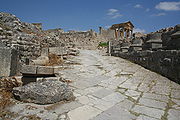
Imperial cult (ancient Rome)
The Imperial cult of ancient Rome identified emperors and some members of their families with the divinely sanctioned authority of the Roman State...
to have been located precisely at Dougga. Fragments of an inscription on the temple's lintel
Lintel (architecture)
A lintel can be a load-bearing building component, a decorative architectural element, or a combined ornamented structural item. It is often found over portals, doors, and windows.-Structural uses:...
were discovered in 1835, but the temple was not identified until 1966. It features a nymphaeum
Nymphaeum
A nymphaeum or nymphaion , in ancient Greece and Rome, was a monument consecrated to the nymphs, especially those of springs....
that dates to the reign of Commodus
Commodus
Commodus , was Roman Emperor from 180 to 192. He also ruled as co-emperor with his father Marcus Aurelius from 177 until his father's death in 180. His name changed throughout his reign; see changes of name for earlier and later forms. His accession as emperor was the first time a son had succeeded...
.
The temple, which is relatively narrow, has an unusual design. It is 41.5 metres long and 14.2 metres wide, and is situated beside the road that descends from the forum to the Aïn Doura Bath. The temple is associated with a triumphal arch
Triumphal arch
A triumphal arch is a monumental structure in the shape of an archway with one or more arched passageways, often designed to span a road. In its simplest form a triumphal arch consists of two massive piers connected by an arch, crowned with a flat entablature or attic on which a statue might be...
over the road. The temple can be accessed via a semi-circular staircase; in each corner of the courtyard in front of the staircase is a reservoir for rain water. The cella
Cella
A cella or naos , is the inner chamber of a temple in classical architecture, or a shop facing the street in domestic Roman architecture...
inside the sanctuary features six lateral niches which are designed to hold the bases of statues of Apollo
Apollo
Apollo is one of the most important and complex of the Olympian deities in Greek and Roman mythology...
, Liber
Liber
In ancient Roman religion and mythology, Liber , also known as Liber Pater was a god of viticulture and wine, fertility and freedom. He was a patron deity of Rome's plebeians and was part of their Aventine Triad. His festival of Liberalia became associated with free speech and the rights...
, Neptune
Neptune (mythology)
Neptune was the god of water and the sea in Roman mythology and religion. He is analogous with, but not identical to, the Greek god Poseidon. In the Greek-influenced tradition, Neptune was the brother of Jupiter and Pluto, each of them presiding over one of the three realms of the universe,...
, Mercury
Mercury (mythology)
Mercury was a messenger who wore winged sandals, and a god of trade, the son of Maia Maiestas and Jupiter in Roman mythology. His name is related to the Latin word merx , mercari , and merces...
and of two other gods that can no longer be identified.
The temple can be seen from afar, but passers-by can only see the cella
Cella
A cella or naos , is the inner chamber of a temple in classical architecture, or a shop facing the street in domestic Roman architecture...
, the foundations of which are decoratively rusticated
Rustication (architecture)
thumb|upright|Two different styles of rustication in the [[Palazzo Medici-Riccardi]] in [[Florence]].In classical architecture rustication is an architectural feature that contrasts in texture with the smoothly finished, squared block masonry surfaces called ashlar...
. Seven columns are spaced along the cella, linking to the lateral door, which opens onto the staircase. The tetrastyle temple is built in Tuscan order
Tuscan order
Among canon of classical orders of classical architecture, the Tuscan order's place is due to the influence of the Italian Sebastiano Serlio, who meticulously described the five orders including a "Tuscan order", "the solidest and least ornate", in his fourth book of Regole generalii di...
in antis. The temple's design is unusual inasmuch as temples of the imperial cult are generally Corinthian
Corinthian order
The Corinthian order is one of the three principal classical orders of ancient Greek and Roman architecture. The other two are the Doric and Ionic. When classical architecture was revived during the Renaissance, two more orders were added to the canon, the Tuscan order and the Composite order...
and located in the middle of a vast courtyard with a portico; the Tuscan order was thus quite rare in the provinces.
The temple therefore bears witness to a desire to construct something that was different to other such buildings, doubtless in response to the constraints created by the terrain. The dedication in the temple sheds light on its construction: the inscription, which has been very precisely dated to 214 CE, consecrates the temple to the personification of victory, Victoria
Victoria (mythology)
In ancient Roman religion, Victoria was the personified goddess of victory. She is the Roman equivalent of the Greek goddess Nike, and was associated with Bellona. She was adapted from the Sabine agricultural goddess Vacuna and had a temple on the Palatine Hill...
, here specifically in connection with the emperor’s campaigns in Germany, for the welfare of Caracalla and of his mother Iulia Domna.
The text recalls the military projects of the son of Septimius Severus
Septimius Severus
Septimius Severus , also known as Severus, was Roman Emperor from 193 to 211. Severus was born in Leptis Magna in the province of Africa. As a young man he advanced through the customary succession of offices under the reigns of Marcus Aurelius and Commodus. Severus seized power after the death of...
and their celebration within the context of the imperial cult. This inscription also explains that the temple was constructed at a cost of 100,000 sestertii
Sestertius
The sestertius, or sesterce, was an ancient Roman coin. During the Roman Republic it was a small, silver coin issued only on rare occasions...
on the wishes of a great lady of Dougga named Gabinia Hermiona after her death. Besides the generosity of this act of philanthropy, her will foresaw the holding of an annual banquet for the ordo decurionum
Decurion (administrative)
A decurion was a member of a city senate in the Roman Empire. Decurions were drawn from the curiales class, which was made up of the wealthy middle class citizens of a town society....
to be financed by her inheritors on the anniversary of the dedication of the temple. At the same time, Gabinia Hermiona bequeathed the land for the circus “for the pleasure of the people”.
The temple occupied what was doubtlessly one of the last free spaces in the vicinity of the forum. The temple’s benefactor preferred this site in the city centre to those that she owned in the outskirts: the site of the circus or the site where the Temple of Celeste was later built. Gabinia’s family, one of the richest in Dougga, was well placed within Carthage’s notables and maintained its power at Dougga, even during the reduction of the local aristocracy in the 3rd century. The terms of Gabinia’s will provide evidence of her concern that the family should endure - the annual banquet would keep alive the memory of the family’s generosity and emphasise its sociability, while the circus would provide for the pleasure of the most humble of the city’s inhabitants.
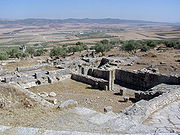
Temple of Pluto
PlutoPluto (mythology)
In ancient Greek religion and myth, Pluto was a name for the ruler of the underworld; the god was also known as Hades, a name for the underworld itself...
receives particular honour at Dougga as the city’s patron divinity, as demonstrated by the Genius
Genius (mythology)
In ancient Roman religion, the genius was the individual instance of a general divine nature that is present in every individual person, place or thing.-Nature of the genius:...
Thuggae.
It is possible that the Temple of Pluto is located near Septimius Severus’ triumphal arch in an area of the city that has only been partially excavated as yet, but this hypothesis is not very firm and is based on the discovery of a bust in a courtyard, which has been dated by Claude Poinssot to the 2nd or 3rd century CE. The associated building was excavated in the 1960s but little is known about the manner in which the excavation was conducted and the stabilisation work carried out at the site. A cella with just one niche has been discovered on a podium in the middle of a courtyard and the altar has also been preserved.
An architectural study was carried out between 2000 and 2002, but it did not lead to any excavation work.
Temple of Saturn

Saturn (mythology)
In ancient Roman religion and myth, Saturn was a major god presiding over agriculture and the harvest time. His reign was depicted as a Golden Age of abundance and peace by many Roman authors. In medieval times he was known as the Roman god of agriculture, justice and strength. He held a sickle in...
was the successor of the Punic Ba'al Hammon and was the attendant (paredros) of Tanit
Tanit
Tanit was a Phoenician lunar goddess, worshipped as the patron goddess at Carthage. Tanit was worshiped in Punic contexts in the Western Mediterranean, from Malta to Gades into Hellenistic times. From the fifth century BCE onwards Tanit is associated with that of Baal Hammon...
or Juno Caelestis
Juno (mythology)
Juno is an ancient Roman goddess, the protector and special counselor of the state. She is a daughter of Saturn and sister of the chief god Jupiter and the mother of Mars and Vulcan. Juno also looked after the women of Rome. Her Greek equivalent is Hera...
. During the Roman era, the city of Dougga had at least two sanctuaries dedicated to Saturn. The evidence for the existence of one of the two derives mostly from inscriptions found in the city. The second temple, which is the one commonly known as the Temple of Saturn at Dougga, has been excavated. The remains of this temple, which are less significant than those of the capitol or the Temple of Juno Caelestis, are of particular interest because of their location. The ruins lie atop a promontory
Promontory
Promontory may refer to:*Promontory, a prominent mass of land which overlooks lower lying land or a body of water*Promontory, Utah, the location where the United States first Transcontinental Railroad was completed...
that overlooks the rich cereal
Cereal
Cereals are grasses cultivated for the edible components of their grain , composed of the endosperm, germ, and bran...
valley of the Oued Khalled, 160 metres from the theatre and outside the bounds of the city. During the excavation works, remains of a temple of Ba'al Hammon, particularly favissae (ritual ditches) containing ex-voto
Ex-voto
An ex-voto is a votive offering to a saint or divinity. It is given in fulfillment of a vow or in gratitude or devotion...
s, were discovered. The Roman temple thus replaced an indigenous sanctuary that dated back at least to the 2nd century BCE. This sanctuary consisted essentially of a wide open space designed to receive ex-votos and sacrifices. It was covered over to facilitate the construction of the Temple of Saturn, the ruins of which can still be seen today.
The Roman temple was built during the reign of Septimius Severus. It consists of three cella
Cella
A cella or naos , is the inner chamber of a temple in classical architecture, or a shop facing the street in domestic Roman architecture...
e, a courtyard with a portico
Portico
A portico is a porch leading to the entrance of a building, or extended as a colonnade, with a roof structure over a walkway, supported by columns or enclosed by walls...
, and a vestibule
Vestibule (architecture)
A vestibule is a lobby, entrance hall, or passage between the entrance and the interior of a building.The same term can apply to structures in modern or ancient roman architecture. In modern architecture vestibule typically refers to a small room or hall between an entrance and the interior of...
. Water from the temple roof was collected in cisterns. An inscription provides details about the temple’s construction: it was erected using funds bequeathed in the testament of a notable local resident named Lucius Octavius Victor Roscianus at a cost of at least 150000 sestertii
Sestertius
The sestertius, or sesterce, was an ancient Roman coin. During the Roman Republic it was a small, silver coin issued only on rare occasions...
, which seems expensive but may be explained by the extent of the earthworks required to give the temple a solid foundation; these works nonetheless seem to have proven insufficient as work to restore and shore up the edifice appear to have been carried out before it finally fell into ruin.
Temple of Juno Caelestis
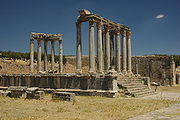
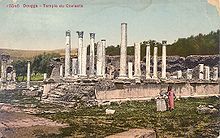
Tanit
Tanit was a Phoenician lunar goddess, worshipped as the patron goddess at Carthage. Tanit was worshiped in Punic contexts in the Western Mediterranean, from Malta to Gades into Hellenistic times. From the fifth century BCE onwards Tanit is associated with that of Baal Hammon...
. Its well-preserved temenos
Temenos
Temenos is a piece of land cut off and assigned as an official domain, especially to kings and chiefs, or a piece of land marked off from common uses and dedicated to a god, a sanctuary, holy grove or holy precinct: The Pythian race-course is called a temenos, the sacred valley of the Nile is the ...
is demarcated by a wall, a large section of which has been very well preserved. The court is only partially tiled and has two symmetrical doors. A portico with 25 bays
Bay (architecture)
A bay is a unit of form in architecture. This unit is defined as the zone between the outer edges of an engaged column, pilaster, or post; or within a window frame, doorframe, or vertical 'bas relief' wall form.-Defining elements:...
runs along the circular section of the temenos. The portico is topped with a frieze
Frieze
thumb|267px|Frieze of the [[Tower of the Winds]], AthensIn architecture the frieze is the wide central section part of an entablature and may be plain in the Ionic or Doric order, or decorated with bas-reliefs. Even when neither columns nor pilasters are expressed, on an astylar wall it lies upon...
depicting the construction of the temple.
The temple in the strict sense of the word stands on a high podium that can be accessed via a series of eleven steps. It is a Corinthian
Corinthian order
The Corinthian order is one of the three principal classical orders of ancient Greek and Roman architecture. The other two are the Doric and Ionic. When classical architecture was revived during the Renaissance, two more orders were added to the canon, the Tuscan order and the Composite order...
hexastyle peripteros
Peripteros
Peripteros is the special name given to a type of ancient Greek or Roman temple surrounded by a portico with columns. It refers to the useful element for the architectural definition of buildings surrounded around their outside by a colonnade on all four sides of the cella , creating a four-sided...
. The pediment
Pediment
A pediment is a classical architectural element consisting of the triangular section found above the horizontal structure , typically supported by columns. The gable end of the pediment is surrounded by the cornice moulding...
features a dedication to Alexander Severus
Alexander Severus
Severus Alexander was Roman Emperor from 222 to 235. Alexander was the last emperor of the Severan dynasty. He succeeded his cousin Elagabalus upon the latter's assassination in 222, and was ultimately assassinated himself, marking the epoch event for the Crisis of the Third Century — nearly fifty...
. The cella
Cella
A cella or naos , is the inner chamber of a temple in classical architecture, or a shop facing the street in domestic Roman architecture...
has been completely lost.
The temple, which was erected between 222 and 235 CE, was paid for by a certain Q. Gabinius Rufus Felix, who donated inter alia two silver statues of Juno Caelestis that cost 35000 sestertii
Sestertius
The sestertius, or sesterce, was an ancient Roman coin. During the Roman Republic it was a small, silver coin issued only on rare occasions...
.
The temenos, which is 52 metres in diameter, is reminiscent of a crescent
Crescent
In art and symbolism, a crescent is generally the shape produced when a circular disk has a segment of another circle removed from its edge, so that what remains is a shape enclosed by two circular arcs of different diameters which intersect at two points .In astronomy, a crescent...
moon, the symbol of Juno Caelestis.
Dar Lacheb

Dar Lacheb was excavated at the end of the 19th century by Louis Carton and has not been the subject of further works since 1912. A house that was built nearby re-using antique remains was destroyed at the start of the 20th century.
Dar Lacheb was built between 164 and 166 CE, at the same era as the capitol, which is 50 metres away. The entrance to the building has been perfectly preserved, as has one of the columns of the entrance porch. The interior consists of a courtyard that was once surrounded with a portico. To the south is the cella of a temple that has been entirely destroyed.
Victoria Church
The Victoria Church, which stands in the northeast of the site, below the Temple of Saturn, is the only Christian building that has been so far excavated at Dougga. At the end of the 4th century CE or at the start of the 5th century, the Christian community erected the unusually designed little church in a paganPaganism
Paganism is a blanket term, typically used to refer to non-Abrahamic, indigenous polytheistic religious traditions....
cemetery
Cemetery
A cemetery is a place in which dead bodies and cremated remains are buried. The term "cemetery" implies that the land is specifically designated as a burying ground. Cemeteries in the Western world are where the final ceremonies of death are observed...
. The small hypogeum
Hypogeum
Hypogeum or hypogaeum literally means "underground", from Greek hypo and gaia . It usually refers to an underground, non-Christian temple or a tomb...
is located nearby.
Cisterns and aqueducts
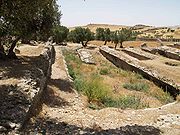
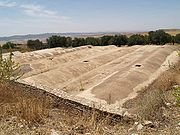
Aqueduct
An aqueduct is a water supply or navigable channel constructed to convey water. In modern engineering, the term is used for any system of pipes, ditches, canals, tunnels, and other structures used for this purpose....
leading to the city, located a short distance from the well-preserved cisterns, is amongst the best preserved examples of this type of structure on the territory of modern-day Tunisia.
The six cisterns of Aïn El Hammam, situated close to the Temple of Juno Caelestis, have a total capacity of 6000 m³ but are in ruins. They were fed by a spring 12 kilometres away and an aqueduct constructed during the reign of Commodus
Commodus
Commodus , was Roman Emperor from 180 to 192. He also ruled as co-emperor with his father Marcus Aurelius from 177 until his father's death in 180. His name changed throughout his reign; see changes of name for earlier and later forms. His accession as emperor was the first time a son had succeeded...
and restored in the last quarter of the 4th century CE.
This site is still used once annually for a festival celebrating Mokhola, who was a female saint and benefactor of Moroccan
Morocco
Morocco , officially the Kingdom of Morocco , is a country located in North Africa. It has a population of more than 32 million and an area of 710,850 km², and also primarily administers the disputed region of the Western Sahara...
origin according to local oral tradition
Oral tradition
Oral tradition and oral lore is cultural material and traditions transmitted orally from one generation to another. The messages or testimony are verbally transmitted in speech or song and may take the form, for example, of folktales, sayings, ballads, songs, or chants...
. The veneration of Mokhola is accompanied with animal sacrifices. It has been shown that this tradition has pagan origins; the object of veneration was originally the spring, known as fons moccolitanus.
The second network of cisterns, the cisterns of Aïn Mizeb, is very well preserved. Located close to the Temple of Minerva, these eight domed reservoirs can hold 9000 m³ and feature a basin into which they decant. The cisterns are fed by a spring located 200 metres away connected via an underground aqueduct.
A final network of secondary cisterns is located in the vicinity of the Aïn Doura Bath, in the south-west of the site.
Streets
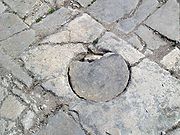
Cardo
The cardo was a north-south oriented street in Roman cities, military camps, and coloniae. The cardo, an integral component of city planning, was lined with shops and vendors, and served as a hub of economic life. The main cardo was called cardo maximus.Most Roman cities also had a Decumanus...
and a decumanus
Decumanus Maximus
In Roman city planning, a decumanus was an east-west-oriented road in a Roman city, castra , or colonia. The main decumanus was the Decumanus Maximus, which normally connected the Porta Praetoria to the Porta Decumana .This name comes from the fact that the via decumana or decimana In Roman city...
– as a result of the city’s unique design.
The centre of the city was probably paved; the streets resembled meandering lanes. The city had sewers, as is evidenced by the access stones that are still in place in the streets. At the foot of the hill, there are traces of streets joining with the main road from Carthage
Carthage
Carthage , implying it was a 'new Tyre') is a major urban centre that has existed for nearly 3,000 years on the Gulf of Tunis, developing from a Phoenician colony of the 1st millennium BC...
to Theveste
Tébessa
Tébessa is the capital city of Tébessa Province, Algeria, 20 kilometers west from the border with Tunisia. Nearby is also a phosphate mine. The city is famous for the traditional Algerian carpets in the region, and is home to over 161,440 people.-History:...
Discoveries made at Dougga
The site at Dougga has offered up numerous works or art, many of which have been removed and placed in museums, most notably the Bardo National Museum in TunisTunis
Tunis is the capital of both the Tunisian Republic and the Tunis Governorate. It is Tunisia's largest city, with a population of 728,453 as of 2004; the greater metropolitan area holds some 2,412,500 inhabitants....
.
Works in situ
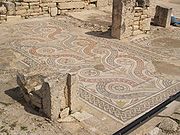
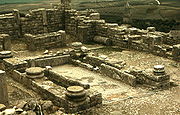
A proposal to construct a museum on the site is being studied. It would serve in particular to house recent discoveries and those yet to be made.
Statues
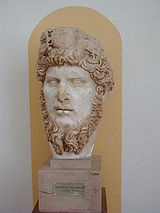
Lucius Verus
Lucius Verus , was Roman co-emperor with Marcus Aurelius, from 161 until his death.-Early life and career:Lucius Verus was the first born son to Avidia Plautia and Lucius Aelius Verus Caesar, the first adopted son and heir of Roman Emperor Hadrian . He was born and raised in Rome...
is particularly noteworthy: he is depicted with a generous head of hair, a full beard and a vivacity that makes it one of the most significant statues yet discovered in Roman Africa
Roman Africa
Roman Africa may mean:*the Roman Africa province*the history of Africa during the Roman era, see North Africa during Antiquity#Roman era...
. This African masterpiece was realised in marble from Carrara
Carrara
Carrara is a city and comune in the province of Massa-Carrara , notable for the white or blue-grey marble quarried there. It is on the Carrione River, some west-northwest of Florence....
and still has traces of colour amongst the hairs.
The museum also houses a togatus that dates from the 3rd century CE. It depicts an aged man, who has a short beard and is dressed in a toga
Toga
The toga, a distinctive garment of Ancient Rome, was a cloth of perhaps 20 ft in length which was wrapped around the body and was generally worn over a tunic. The toga was made of wool, and the tunic under it often was made of linen. After the 2nd century BC, the toga was a garment worn...
. It seems certain that this is a later work of art reflective of the contemporary taste in art.
Mosaics
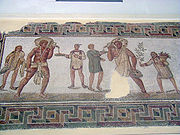
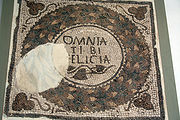
The butler’s mosaic dating from the middle of the 3rd century CE features a drinking scene. Two characters are serving two others, who are much smaller, from amphora
Amphora
An amphora is a type of vase-shaped, usually ceramic container with two handles and a long neck narrower than the body...
s on their shoulders. The two amphoras bear the letters PIE (“Drink!” in Ancient Greek
Ancient Greek
Ancient Greek is the stage of the Greek language in the periods spanning the times c. 9th–6th centuries BC, , c. 5th–4th centuries BC , and the c. 3rd century BC – 6th century AD of ancient Greece and the ancient world; being predated in the 2nd millennium BC by Mycenaean Greek...
) and ZHCHC (“You will live” in Ancient Greek
Ancient Greek
Ancient Greek is the stage of the Greek language in the periods spanning the times c. 9th–6th centuries BC, , c. 5th–4th centuries BC , and the c. 3rd century BC – 6th century AD of ancient Greece and the ancient world; being predated in the 2nd millennium BC by Mycenaean Greek...
). The amphora bearers are flanked by another two characters, one of whom is carrying another amphora, the other of whom is carrying a branch of laurel
Bay Laurel
The bay laurel , also known as sweet bay, bay tree, true laurel, Grecian laurel, laurel tree, or simply laurel, is an aromatic evergreen tree or large shrub with green, glossy leaves, native to the Mediterranean region. It is the source of the bay leaf used in cooking...
and a basket of rose
Rose
A rose is a woody perennial of the genus Rosa, within the family Rosaceae. There are over 100 species. They form a group of erect shrubs, and climbing or trailing plants, with stems that are often armed with sharp prickles. Flowers are large and showy, in colours ranging from white through yellows...
s. This depiction is a greeting to all guests and a promise of hospitality. The same is true of another mosaic held at the museum which bears the phrase Omnia tibi felicia (May everything please you).
The mosaic of the victorious charioteer is younger than these works. It dates from the second half of the 4th century CE, and features the phrase Eros omnia per te (Eros everything for you). The depiction of the charioteer shows great attention to realism, as do the depictions of the horses, two of which are named Amandus and Frunitus after their characters. The horses are arranged symmetrically; such symmetries were very popular at the time. The charioteer is holding a whip
Whip
A whip is a tool traditionally used by humans to exert control over animals or other people, through pain compliance or fear of pain, although in some activities whips can be used without use of pain, such as an additional pressure aid in dressage...
, a crown made of branches
Laurel wreath
A laurel wreath is a circular wreath made of interlocking branches and leaves of the bay laurel , an aromatic broadleaf evergreen. In Greek mythology, Apollo is represented wearing a laurel wreath on his head...
and a palm branch
Palm branch (symbol)
A palm branch , usually refers to the leaves of the Arecaceae ....
. The starting blocks of the circus
Circus (building)
The Roman circus was a large open-air venue used for public events in the ancient Roman Empire. The circuses were similar to the ancient Greek hippodromes, although serving varying purposes. Along with theatres and amphitheatres, Circuses were one of the main entertainment sites of the time...
can be seen in the background. This work of art was found in a private residence and it appears that it must be interpreted as a monument donated by the owner celebrating the victory of a charioteer named Eros.
The Ulysses mosaic is a work inspired by the Odyssey
Odyssey
The Odyssey is one of two major ancient Greek epic poems attributed to Homer. It is, in part, a sequel to the Iliad, the other work ascribed to Homer. The poem is fundamental to the modern Western canon, and is the second—the Iliad being the first—extant work of Western literature...
: the Greek hero
Odysseus
Odysseus or Ulysses was a legendary Greek king of Ithaca and the hero of Homer's epic poem the Odyssey. Odysseus also plays a key role in Homer's Iliad and other works in the Epic Cycle....
is seen standing on a boat that is decorated with a human head and a palm branch and that has two sails and a battering ram. Ulysses’s hands are tied to the main mast so that he will not succumb to the fatal charm of the siren
Siren
In Greek mythology, the Sirens were three dangerous mermaid like creatures, portrayed as seductresses who lured nearby sailors with their enchanting music and voices to shipwreck on the rocky coast of their island. Roman poets placed them on an island called Sirenum scopuli...
s’ music. Ulysses’s companions are seated around him, their ears blocked with wax
Wax
thumb|right|[[Cetyl palmitate]], a typical wax ester.Wax refers to a class of chemical compounds that are plastic near ambient temperatures. Characteristically, they melt above 45 °C to give a low viscosity liquid. Waxes are insoluble in water but soluble in organic, nonpolar solvents...
as described in the legend. Three sirens stand at the base of a rocky crag. They are depicted with the bust of a woman, but with the wings and legs of a bird. One of them holds a flute
Flute
The flute is a musical instrument of the woodwind family. Unlike woodwind instruments with reeds, a flute is an aerophone or reedless wind instrument that produces its sound from the flow of air across an opening...
, the second a lyre
Lyre
The lyre is a stringed musical instrument known for its use in Greek classical antiquity and later. The word comes from the Greek "λύρα" and the earliest reference to the word is the Mycenaean Greek ru-ra-ta-e, meaning "lyrists", written in Linear B syllabic script...
, while the third, who does not carry an instrument, is believed to be the singing siren. In front of Ulysses’s boat, there is a small barque
Barque
A barque, barc, or bark is a type of sailing vessel with three or more masts.- History of the term :The word barque appears to have come from the Greek word baris, a term for an Egyptian boat. This entered Latin as barca, which gave rise to the Italian barca, Spanish barco, and the French barge and...
with a fisherman holding a lobster
Lobster
Clawed lobsters comprise a family of large marine crustaceans. Highly prized as seafood, lobsters are economically important, and are often one of the most profitable commodities in coastal areas they populate.Though several groups of crustaceans are known as lobsters, the clawed lobsters are most...
, the depiction of which is over-sized. The mosaic has been dated to around 260-268 CE; it was discovered in the “house of Ulysses and the pirates”.
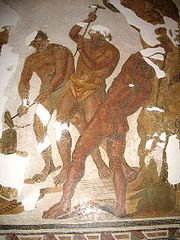
Peristyle
In Hellenistic Greek and Roman architecture a peristyle is a columned porch or open colonnade in a building surrounding a court that may contain an internal garden. Tetrastoon is another name for this feature...
as the preceding work. It depicts the punishment of pirates on the Tyrrhenian Sea
Tyrrhenian Sea
The Tyrrhenian Sea is part of the Mediterranean Sea off the western coast of Italy.-Geography:The sea is bounded by Corsica and Sardinia , Tuscany, Lazio, Campania, Basilicata and Calabria and Sicily ....
, merging themes linked to Dionysus
Dionysus
Dionysus was the god of the grape harvest, winemaking and wine, of ritual madness and ecstasy in Greek mythology. His name in Linear B tablets shows he was worshipped from c. 1500—1100 BC by Mycenean Greeks: other traces of Dionysian-type cult have been found in ancient Minoan Crete...
and more common marine themes. The god is standing, ready to throw his spear. He is supported by a maenad
Maenad
In Greek mythology, maenads were the female followers of Dionysus , the most significant members of the Thiasus, the god's retinue. Their name literally translates as "raving ones"...
, a satyr
Satyr
In Greek mythology, satyrs are a troop of male companions of Pan and Dionysus — "satyresses" were a late invention of poets — that roamed the woods and mountains. In myths they are often associated with pipe-playing....
and aged Silenus
Silenus
In Greek mythology, Silenus was a companion and tutor to the wine god Dionysus.-Evolution of the character:The original Silenus resembled a folklore man of the forest with the ears of a horse and sometimes also the tail and legs of a horse...
, who is holding the ship’s rudder
Rudder
A rudder is a device used to steer a ship, boat, submarine, hovercraft, aircraft or other conveyance that moves through a medium . On an aircraft the rudder is used primarily to counter adverse yaw and p-factor and is not the primary control used to turn the airplane...
. A leopard
Leopard
The leopard , Panthera pardus, is a member of the Felidae family and the smallest of the four "big cats" in the genus Panthera, the other three being the tiger, lion, and jaguar. The leopard was once distributed across eastern and southern Asia and Africa, from Siberia to South Africa, but its...
is attacking one of the pirates, who are transformed into dolphins as soon as they recognise the divine nature of their adversary. To the left, genii
Genius (mythology)
In ancient Roman religion, the genius was the individual instance of a general divine nature that is present in every individual person, place or thing.-Nature of the genius:...
have boarded another ship, while to the right, fishermen are attempting to catch an octopus
Octopus
The octopus is a cephalopod mollusc of the order Octopoda. Octopuses have two eyes and four pairs of arms, and like other cephalopods they are bilaterally symmetric. An octopus has a hard beak, with its mouth at the center point of the arms...
with a net.
Mohamed Yacoub attributes a protective function to these two scenes, a means of invoking fate, a practice which is probably based on Hellenic tradition.
The mosaic of the cyclopses forging Jupiter’s thunderbolts from the floor of a frigidarium
Frigidarium
A frigidarium is a large cold pool of Roman baths. It would be entered after the Caldarium and the Tepidarium, which were used to open the pores of the skin. The cold water would close the pores. There would be a small pool of cold water or sometimes a large Swimming pool...
depicts three cyclops
Cyclops
A cyclops , in Greek mythology and later Roman mythology, was a member of a primordial race of giants, each with a single eye in the middle of his forehead...
es: Brontes, Steropes and Pyracmon (Arges). They are depicted naked, forging Jupiter
Jupiter (mythology)
In ancient Roman religion and myth, Jupiter or Jove is the king of the gods, and the god of the sky and thunder. He is the equivalent of Zeus in the Greek pantheon....
’s thunderbolts, which Vulcan
Vulcan (mythology)
Vulcan , aka Mulciber, is the god of beneficial and hindering fire, including the fire of volcanoes in ancient Roman religion and Roman Neopaganism. Vulcan is usually depicted with a thunderbolt. He is known as Sethlans in Etruscan mythology...
, seated in front of them, is holding on an anvil
Anvil
An anvil is a basic tool, a block with a hard surface on which another object is struck. The inertia of the anvil allows the energy of the striking tool to be transferred to the work piece. In most cases the anvil is used as a forging tool...
. This last element has been lost. The mosaic dates to the end of the 3rd century CE and was discovered in the Bath of the Cyclopses.
Works held in other museums
The bilingual inscription from the mausoleum taken by British Consul Read is held by the British MuseumBritish Museum
The British Museum is a museum of human history and culture in London. Its collections, which number more than seven million objects, are amongst the largest and most comprehensive in the world and originate from all continents, illustrating and documenting the story of human culture from its...
. The inscription shows the same text in both the Punic language
Punic language
The Punic language or Carthagian language is an extinct Semitic language formerly spoken in the Mediterranean region of North Africa and several Mediterranean islands, by people of the Punic culture.- Description :...
and the Libyan language
Berber languages
The Berber languages are a family of languages indigenous to North Africa, spoken from Siwa Oasis in Egypt to Morocco , and south to the countries of the Sahara Desert...
.
Rediscovery and future of the site
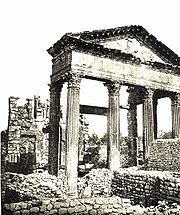
Byzantine
Byzantine usually refers to the Roman Empire during the Middle Ages.Byzantine may also refer to:* A citizen of the Byzantine Empire, or native Greek during the Middle Ages...
era saw the area around the forum transformed into a fort; several important buildings were destroyed in order to provide the necessary materials for its construction. Dougga was however never completely abandoned, and for a long time, it was the site of a village populated by the descendents of the city’s former inhabitants, as is evidenced by the small mosque situated in the Temple of August Piety and the small bath dating to the Aghlabid
Aghlabid
The Aghlabids were a dynasty of emirs, members of the Arab tribe of Bani Tamim, who ruled Ifriqiya, nominally on behalf of the Abbasid Caliph, for about a century, until overthrown by the new power of the Fatimid.-History:...
period on the southern flank of the forum.
The first Western visitors to have left eyewitness accounts of the ruins reached the site in the 17th century. This trend continued in the 18th century and at the start of the 19th century. The best-preserved monuments, including the mausoleum, were described and, at the end of this period, were the object of architectural studies.
The establishment of the French Protectorate in Tunisia in 1881 led to the creation of a national antiquities institute (Institut national du patrimoine), for which the excavation of the site at Dougga was a priority from 1901, parallel to the works carried out at Carthage
Carthage
Carthage , implying it was a 'new Tyre') is a major urban centre that has existed for nearly 3,000 years on the Gulf of Tunis, developing from a Phoenician colony of the 1st millennium BC...
. The works at Dougga concentrated at first on the area around the forum; other discoveries ensured that there was an almost constant series of digs ar the site until 1939. Alongside these excavations, work was conducted to restore the capitol, of which only the front and the base of the wall of the cella were still standing, and in particular between 1908 and 1910 to restore the mausoleum.
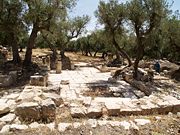
UNESCO
The United Nations Educational, Scientific and Cultural Organization is a specialized agency of the United Nations...
list of World Heritage Site
World Heritage Site
A UNESCO World Heritage Site is a place that is listed by the UNESCO as of special cultural or physical significance...
s.
Despite its importance and its exceptional state, Dougga remains off the beaten track for many tourists (the site receives around 50000 visitors per year). In order to make it more attractive, the construction of an on-site museum is being considered, while the Institut national du patrimoine has established a website presenting the site and the surrounding region. For the time being, visitors with sufficient time can appreciate Dougga, not only because of its many ruins, but also for its olive groves, which give the site a unique ambiance.
French
Aïcha Ben Abed-Ben Khader, Le musée du Bardo, éd. Cérès, Tunis, 1992 ISBN 997370083X Claude Briand-Ponsart et Christophe Hugoniot, L’Afrique romaine. De l’Atlantique à la Tripolitaine. 146 av. J.-C. - 533 apr. J.-C., éd. Armand Colin, Paris, 2005 ISBN 2200268386 Gabriel CampsGabriel Camps
Gabriel Camps was a French historian, founder of the Encyclopédie berbère and considered a prestigious scholar in Berber historical studies.-Biography:Gabriel Camps was born in Misserghine...
, « Dougga », L’Encyclopédie berbère
Encyclopédie berbère
Encyclopédie berbère is a French-language encyclopaedia dealing with subjects related to the Berber people. It was launched in 1984 under the aegis of UNESCO and is published by Editions Edisud. Its first editor-in-chief was Gabriel Camps...
, tome XVI, éd. Edisud, Aix-en-Provence, 1992, pp. 2522–2527 ISBN 2857445814 Gabriel Camps
Gabriel Camps
Gabriel Camps was a French historian, founder of the Encyclopédie berbère and considered a prestigious scholar in Berber historical studies.-Biography:Gabriel Camps was born in Misserghine...
, Les Berbères, mémoire et identité, coll. Babel, éd. Actes Sud/Leméac, Paris/Montréal, 2007 ISBN 9782742769223 Michel Christol, Regards sur l’Afrique romaine, éd. Errance, Paris, 2005 ISBN 2877723135 Paul Corbier et Marc Griesheimer, L’Afrique romaine. 146 av. J.-C. - 439 apr. J.-C., éd. Ellipses, Paris, 2005 ISBN 2729824413 Jacques Gascou, La politique municipale de l’empire romain en Afrique proconsulaire de Trajan à Septime Sévère, éd. CEFR, Rome, 1972 Jean-Claude Golvin, L’antiquité retrouvée, éd. Errance, Paris, 2003 ISBN 287772266X Pierre Gros, L’architecture romaine du début du IIIe siècle à la fin du Haut-Empire, tome 1 « Monuments publics », éd. Picard, Paris, 1996 ISBN 2708405004 } Pierre Gros, L’architecture romaine du début du IIIe siècle à la fin du Haut-Empire, tome 2 « Maisons, palais, villas et tombeaux », éd. Picard, Paris, 2001 ISBN 2708405330 Christophe Hugoniot, Rome en Afrique. De la chute de Carthage aux débuts de la conquête arabe, éd. Flammarion, Paris, 2000 ISBN 2080830031 Mustapha Khanoussi, « L’évolution urbaine de Thugga (Dougga) en Afrique proconsulaire : de l’agglomération numide à la ville africo-romaine », CRAI (Comptes-rendus des séances de l’Académie des inscriptions et belles-lettres), 2003, pp. 131–155 Mustapha Khanoussi, Dougga, éd. Agence de mise en valeur du patrimoine et de promotion culturelle, Tunis, 2008 ISBN 9789973954336 Mustapha Khanoussi et Louis Maurin, Dougga (Thugga). Études épigraphiques, éd. Ausonius, Bordeaux, 1997 Mustapha Khanoussi et Louis Maurin, Dougga. Fragments d’histoire. Choix d’inscriptions latines éditées, traduites et commentées (Ier-IVe siècles), éd. Ausonius/Institut national du patrimoine, Bordeaux/Tunis, 2000 Mustapha Khanoussi et Louis Maurin [sous la dir. de], Mourir à Dougga. Recueil des inscriptions funéraires, éd. Ausonius, Bordeaux, 2002 Yann Le Bohec, Histoire de l’Afrique romaine, éd. Picard, Paris, 2005 ISBN 2708407511 Édouard Lipinski [sous la dir. de], Dictionnaire de la civilisation phénicienne et punique, éd. Brépols, Paris, 1992 ISBN 2503500331 Ammar Mahjoubi, Villes et structures de la province romaine d’Afrique, éd. Centre de publication universitaire, Tunis, 2000 ISBN 9973937953 Guillemette Mansour, Tunisie, Musée à ciel ouvert, éd. Dad, Tunis, 2007 (deuxième édition) ISBN 9973512130 Sophie Saint-Amans, Topographie religieuse de Thugga (Dougga). Ville romaine d’Afrique proconsulaire (Tunisie), éd. Ausonius, Bordeaux, 2004 ISBN 291002346X Hédi Slim et Nicolas Fauqué, La Tunisie antique. De Hannibal à saint Augustin, éd. Mengès, Paris, 2001 ISBN 285620421X Yvon Thébert, Thermes romains d’Afrique du Nord et leur contexte méditerranéen, éd. École française de Rome, Rome, 2003 ISBN 2728303983 Mohamed Yacoub, Splendeurs des mosaïques de Tunisie, éd. Agence nationale du patrimoine, Tunis, 1995 ISBN 9973917235 Collectif, La Tunisie, carrefour du monde antique, éd. Faton, Paris, 1995 Collectif, L’Afrique romaine. 69-439, éd. Atlande, Neuilly-sur-Seine, 2006 ISBN 2350300021 Il était une fois, Dougga...Tukka...ou...Thugga la Romaine, éd. Alyssa, Tunis, 1993
Other languages
Mustapha Khanoussi et Volker Michael Strocka, THVGGA I. Grundlagen und Berichte, éd. Philipp von Zabern, Mayence, 2002 ISBN 3805328923 Mustapha Khanoussi, Stefan Ritter et Philipp von Rummel, « The German-Tunisian project at Dougga. First results of the excavations south of the Maison du Trifolium », Antiquités africaines, vol. 40, 2004–2005, pp. 43–66 Rainer Stutz, THVGGA II. Drei Hanghäuser in Thugga : maison des trois masques, maison du labyrinthe, maison de Dionysos et d’Ulysse, éd. Philipp von Zabern, Mayence, 2007 ISBN 3805337582External links
Portail sur le site de Dougga et sa région Étude de l’architecture religieuse de Dougga (Ministère français des affaires étrangères) Fouilles tuniso-allemandes à Dougga (Institut archéologique de l’Université de Fribourg-en-Brisgau) Thugga University of Freiburg- Dougga: Roman Ruins Lexicorient
- Dougga Site UNESCO World Heritage
- Dougga information Dougga information
- Photo Dougga photo

